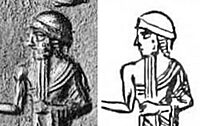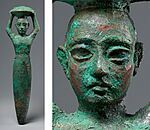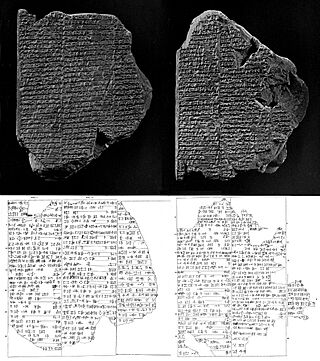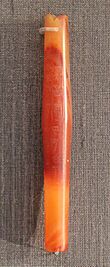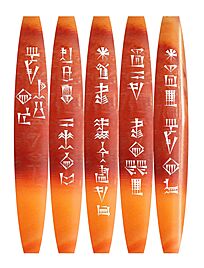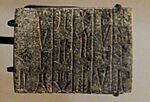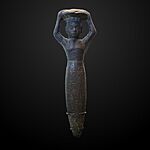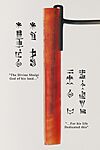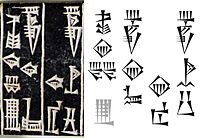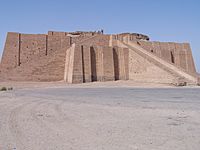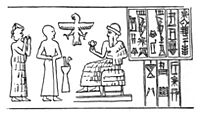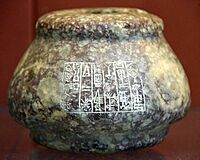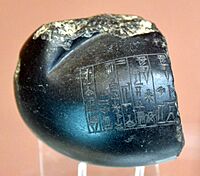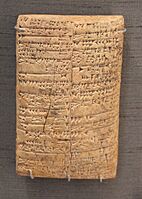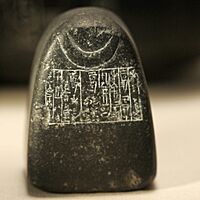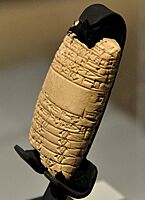Shulgi facts for kids
Quick facts for kids Shulgi𒀭𒂄𒄀 |
|
|---|---|
|
|
 
Cylinder seal of Shulgi. The inscription reads "To Nuska, supreme minister of Enlil, his king, for the life of Shulgi, strong hero, King of Ur, King of Sumer and Akkad, Ur-Nanibgal, governor of Nippur, son of Lugal-engardug, governor of Nippur, dedicated this." Louvre Museum.
|
|
| King of the Neo-Sumerian Empire | |
| Reign | c. 2094 BC – 2046 BC |
| Predecessor | Ur-Nammu |
| Successor | Amar-Sin |
| Issue | Amar-Sin, Liwir-Mitashu |
| Dynasty | 3rd Dynasty of Ur |
| Father | Ur-Nammu |
| Mother | Watartum |
{{multiple image|perrow=2|total_width=330|caption_align=left|footer_align=center | align = right | direction =horizontal | header=King Shulgi foundation tablet
(c. 2094–2046 BC) | image2 = Foundation tablet Reign of Shulgi From the Temple of Dimtabba in Ur (horizontal).jpg | caption2 = dnimin-tab-ba.............. "For Nimintabba"![]()
nin-a-ni..................... "his Lady,"
šul-gi.................... "Shulgi"
nitah kalag-ga...... "the mighty man"
lugal........................"King"
urimki-ma............... "of Ur"![]()
lugal ki-en-............... "King of Sumer"
gi ki-uri-ke4................. "and Akkad,"
e2-a-ni.......................... "her Temple"![]()
mu-na-du3................... "he built" | image1 = Foundation tablet Reign of Shulgi From the Temple of Dimtabba in Ur.jpg | caption1 = {{cuneiform|𒀭 [[Nimintabba|AsFactors|AsFactors|AsFactors|AsFactors|AsFactors|AsFactors|AsFactors|AsFactors|AsFactors|AsFactors|AsFactors|AsFactors|AsFactors|AsFactors|AsFactors|AsFactors|AsFactors|AsFactors|AsFactors|AsFactors|AsFactors|AsFactors|AsFactors|AsFactors|AsFactors|AsFactors|AsFactors|AsFactors|AsFactors|AsFactors|AsFactors|AsFactors|AsFactors|AsFactors|AsFactors|AsFactors|AsFactors|AsFactors|AsFactors|AsFactors|AsFactors|AsFactors|AsFactors|AsFactors|AsFactors|AsFactors|AsFactors|AsFactors|AsFactors|AsFactors|AsFactors|AsFactors|AsFactors|AsFactors|AsFactors|AsFactors|AsFactors|AsFactors|AsFactors|AsFactors|AsFactors|AsFactors|AsFactors|AsFactors|AsFactors|AsFactors|AsFactors|AsFactors|AsFactors|AsFactors|AsFactors|AsFactors|AsFactors|AsFactors|AsFactors|AsFactors|AsFactors|AsFactors|AsFactors|AsFactors|AsFactors|AsFactors|AsFactors|AsFactors|AsFactors|AsFactors|AsFactors|AsFactors|AsFactors|AsFactors|AsFactors|AsFactors|AsFactors|AsFactors|AsFactors|AsFactors|AsFactors|AsFactors|AsFactors|AsFactors|AsFactors|AsFactors|AsFactors|AsFactors|AsFactors|AsFactors|AsFactors|AsFactors|AsFactors|AsFactors|AsFactors|AsFactors|AsFactors|AsFactors|AsFactors|AsFactors|AsFactors|AsFactors|AsFactors|AsFactors|AsFactors|AsFactors|AsFactors|AsFactors|AsFactors|AsFactors|AsFactors|AsFactors|AsFactors|AsFactors|AsFactors|AsFactors|AsFactors|AsFactors|AsFactors|AsFactors|AsFactors|AsFactors|AsFactors|AsFactors|AsFactors|AsFactors|AsFactors|AsFactors|AsFactors|AsFactors|AsFactors|AsFactors|AsFactors|AsFactors|AsFactors|AsFactors|AsFactors|AsFactors|AsFactors|AsFactors|AsFactors|AsFactors|AsFactors|AsFactors|AsFactors|AsFactors|AsFactors|AsFactors|AsFactors|AsFactors|AsFactors|AsFactors|AsFactors|AsFactors|AsFactors|AsFactors|AsFactors|AsFactors|AsFactors|AsFactors|AsFactors|AsFactors|AsFactors|AsFactors|AsFactors|AsFactors|AsFactors|AsFactors|AsFactors|AsFactors|AsFactors|AsFactors|AsFactors|AsFactors|AsFactors|AsFactors|AsFactors|AsFactors|AsFactors|AsFactors|AsFactors|AsFactors|AsFactors|AsFactors|AsFactors|AsFactors|AsFactors|AsFactors|AsFactors|AsFactors|AsFactors|AsFactors|AsFactors|AsFactors|AsFactors|AsFactors|AsFactors|AsFactors|AsFactors|AsFactors|AsFactors|AsFactors|AsFactors|AsFactors|AsFactors|AsFactors|AsFactors|AsFactors|AsFactors|AsFactors|AsFactors|AsFactors|AsFactors|AsFactors|AsFactors|AsFactors|AsFactors|AsFactors|AsFactors|AsFactors|AsFactors|AsFactors|AsFactors|AsFactors|AsFactors|AsFactors|AsFactors|AsFactors|AsFactors|AsFactors|AsFactors|AsFactors|AsFactors|AsFactors|AsFactors|AsFactors|AsFactors|AsFactors|AsFactors|AsFactors|AsFactors|AsFactors|AsFactors|AsFactors|AsFactors|AsFactors|AsFactors|AsFactors|AsFactors|AsFactors|AsFactors|AsFactors|AsFactors|AsFactors|AsFactors|AsFactors|AsFactors|AsFactors|AsFactors|AsFactors|AsFactors|AsFactors|AsFactors|AsFactors|AsFactors|AsFactors|AsFactors|AsFactors|AsFactors|AsFactors|AsFactors|AsFactors|AsFactors|AsFactors|AsFactors|AsFactors|AsFactors|AsFactors|AsFactors|AsFactors|AsFactors|AsFactors|AsFactors|AsFactors|AsFactors|AsFactors|AsFactors|AsFactors|AsFactors|AsFactors|AsFactors|AsFactors|AsFactors|AsFactors|AsFactors|AsFactors|AsFactors|AsFactors|AsFactors|AsFactors|AsFactors|AsFactors|AsFactors|AsFactors|AsFactors|AsFactors|AsFactors|AsFactors|AsFactors|AsFactors|AsFactors|AsFactors|AsFactors|AsFactors|AsFactors|AsFactors|AsFactors|AsFactors|AsFactors|AsFactors|AsFactors|AsFactors|AsFactors|AsFactors|AsFactors|AsFactors|AsFactors|AsFactors|AsFactors|AsFactors|AsFactors|AsFactors|AsFactors|AsFactors|AsFactors|AsFactors|AsFactors|AsFactors|AsFactors|AsFactors|AsFactors|AsFactors|AsFactors|AsFactors|AsFactors|AsFactors|AsFactors|AsFactors|AsFactors|AsFactors|AsFactors|AsFactors|AsFactors|AsFactors|AsFactors|AsFactors|AsFactors|AsFactors|AsFactors|AsFactors|AsFactors|AsFactors|AsFactors|AsFactors|AsFactors|AsFactors|AsFactors|AsFactors|AsFactors|AsFactors|AsFactors|AsFactors|AsFactors|AsFactors|AsFactors|AsFactors|AsFactors|AsFactors|AsFactors|AsFactors|AsFactors|AsFactors|AsFactors|AsFactors|AsFactors|AsFactors|AsFactors|AsFactors|AsFactors|AsFactors|AsFactors|AsFactors|AsFactors|AsFactors|AsFactors|AsFactors|AsFactors|AsFactors|AsFactors|AsFactors|AsFactors|AsFactors|AsFactors|AsFactors|AsFactors|AsFactors|AsFactors|AsFactors|AsFactors|AsFactors|AsFactors|AsFactors|AsFactors|AsFactors|AsFactors|AsFactors|AsFactors|AsFactors|AsFactors|AsFactors|AsFactors|AsFactors|AsFactors|AsFactors|AsFactors|AsFactors|AsFactors|AsFactors|AsFactors|AsFactors|AsFactors|AsFactors|AsFactors|AsFactors|AsFactors|AsFactors|AsFactors|AsFactors|AsFactors|AsFactors|AsFactors|AsFactors|AsFactors|AsFactors|AsFactors|AsFactors|AsFactors|AsFactors|AsFactors|AsFactors|AsFactors|AsFactors|AsFactors|AsFactors|AsFactors|AsFactors|AsFactors|AsFactors|AsFactors|AsFactors|AsFactors|AsFactors|AsFactors|AsFactors|AsFactors|AsFactors|AsFactors|AsFactors|AsFactors|AsFactors|AsFactors|AsFactors|AsFactors|AsFactors|AsFactors|AsFactors|AsFactors|AsFactors|AsFactors|AsFactors|AsFactors|AsFactors|AsFactors|AsFactors|AsFactors|AsFactors|AsFactors|AsFactors|AsFactors|AsFactors|AsFactors|AsFactors|AsFactors|AsFactors|AsFactors|AsFactors|AsFactors|AsFactors|AsFactors|AsFactors|AsFactors|AsFactors|AsFactors|AsFactors|AsFactors|AsFactors|AsFactors|AsFactors|AsFactors|AsFactors|AsFactors|AsFactors|AsFactors|AsFactors|AsFactors|AsFactors|AsFactors|AsFactors|AsFactors|AsFactors|AsFactors|AsFactors|AsFactors|AsFactors|AsFactors|AsFactors|AsFactors|AsFactors|AsFactors|AsFactors|AsFactors|AsFactors|AsFactors|AsFactors|AsFactors|AsFactors|AsFactors|AsFactors|AsFactors|AsFactors|AsFactors|AsFactors|AsFactors|AsFactors|AsFactors|AsFactors|AsFactors|AsFactors|AsFactors|AsFactors|AsFactors|AsFactors|AsFactors|AsFactors|AsFactors|AsFactors|AsFactors|AsFactors|AsFactors|AsFactors|AsFactors|AsFactors|AsFactors|AsFactors|AsFactors|AsFactors|AsFactors|AsFactors|AsFactors|AsFactors|AsFactors|AsFactors|AsFactors|AsFactors|AsFactors|AsFactors|AsFactors|AsFactors|AsFactors|AsFactors|AsFactors|AsFactors|AsFactors|AsFactors|AsFactors|AsFactors|AsFactors|AsFactors|AsFactors|AsFactors|AsFactors|AsFactors|AsFactors|AsFactors|AsFactors|AsFactors|AsFactors|AsFactors|AsFactors|AsFactors|AsFactors|AsFactors|AsFactors|AsFactors|AsFactors|AsFactors|AsFactors|AsFactors|AsFactors|AsFactors|AsFactors|AsFactors|AsFactors|AsFactors|AsFactors|AsFactors|AsFactors|AsFactors|AsFactors|AsFactors|AsFactors|AsFactors|AsFactors|AsFactors|AsFactors|AsFactors|AsFactors|AsFactors|AsFactors|AsFactors|AsFactors|AsFactors|AsFactors|AsFactors|AsFactors|AsFactors|AsFactors|AsFactors|AsFactors|AsFactors|AsFactors|AsFactors|AsFactors|AsFactors|AsFactors|AsFactors|AsFactors|AsFactors|AsFactors|AsFactors|AsFactors|AsFactors|AsFactors|AsFactors|AsFactors|AsFactors|AsFactors|AsFactors|AsFactors|AsFactors|AsFactors|AsFactors|AsFactors|AsFactors|AsFactors|AsFactors|AsFactors|AsFactors|AsFactors|AsFactors|AsFactors|AsFactors|AsFactors|AsFactors|AsFactors|AsFactors|AsFactors|AsFactors|AsFactors|AsFactors|AsFactors|AsFactors|AsFactors|AsFactors|AsFactors|AsFactors|AsFactors|AsFactors|AsFactors|AsFactors|AsFactors|AsFactors|AsFactors|AsFactors|AsFactors|AsFactors|AsFactors|AsFactors|AsFactors|AsFactors|AsFactors|AsFactors|AsFactors|AsFactors|AsFactors|AsFactors|AsFactors|AsFactors|AsFactors|AsFactors|AsFactors|AsFactors|AsFactors|AsFactors|AsFactors|AsFactors|AsFactors|AsFactors|AsFactors|AsFactors|AsFactors|AsFactors|AsFactors|AsFactors|AsFactors|AsFactors|AsFactors|AsFactors|AsFactors|AsFactors|AsFactors|AsFactors|AsFactors|AsFactors|AsFactors|AsFactors|AsFactors|AsFactors|AsFactors|AsFactors|AsFactors|AsFactors|AsFactors|AsFactors|AsFactors|AsFactors|AsFactors|AsFactors|AsFactors|AsFactors|AsFactors|AsFactors|AsFactors|AsFactors|AsFactors|AsFactors|AsFactors|AsFactors|AsFactors|AsFactors|AsFactors|AsFactors|AsFactors|AsFactors|AsFactors|AsFactors|AsFactors|AsFactors|AsFactors|AsFactors|AsFactors|AsFactors|AsFactors|AsFactors|AsFactors|AsFactors|AsFactors|AsFactors|AsFactors|AsFactors|AsFactors|AsFactors|AsFactors|AsFactors|AsFactors|AsFactors|AsFactors|AsFactors|AsFactors|AsFactors|AsFactors|AsFactors|AsFactors|AsFactors|AsFactors|AsFactors|AsFactors|AsFactors|AsFactors|AsFactors|AsFactors|AsFactors|AsFactors|AsFactors|AsFactors|AsFactors|AsFactors|AsFactors|AsFactors|AsFactors|AsFactors|AsFactors|AsFactors|AsFactors|AsFactors|AsFactors|AsFactors|AsFactors|AsFactors|AsFactors|AsFactors|AsFactors|AsFactors|AsFactors|AsFactors|AsFactors|AsFactors|AsFactors|AsFactors|AsFactors|AsFactors|AsFactors|AsFactors|AsFactors|AsFactors|AsFactors|AsFactors|AsFactors|AsFactors|AsFactors|AsFactors|AsFactors|AsFactors|AsFactors|AsFactors|AsFactors|AsFactors|AsFactors|AsFactors|AsFactors|AsFactors|AsFactors|AsFactors|AsFactors|AsFactors|AsFactors|AsFactors|AsFactors|AsFactors|AsFactors|AsFactors|AsFactors|AsFactors|AsFactors|AsFactors|AsFactors|AsFactors|AsFactors|AsFactors|AsFactors|AsFactors|AsFactors|AsFactors|AsFactors|AsFactors|AsFactors|AsFactors|AsFactors|AsFactors|AsFactors|AsFactors|AsFactors|AsFactors|AsFactors|AsFactors|AsFactors|AsFactors|AsFactors|AsFactors|AsFactors|AsFactors|AsFactors|AsFactors|AsFactors|AsFactors|AsFactors|AsFactors|AsFactors|AsFactors|AsFactors|AsFactors|AsFactors|AsFactors|AsFactors|AsFactors|AsFactors|AsFactors|AsFactors|AsFactors|AsFactors|AsFactors|AsFactors|AsFactors|AsFactors|AsFactors|AsFactors|AsFactors|AsFactors|AsFactors|AsFactors|AsFactors|AsFactors|AsFactors|AsFactors|AsFactors|AsFactors|AsFactors|AsFactors|AsFactors|AsFactors|AsFactors|AsFactors|AsFactors|AsFactors|AsFactors|AsFactors|AsFactors|AsFactors|AsFactors|AsFactors|AsFactors|AsFactors|AsFactors|AsFactors|AsFactors|AsFactors|AsFactors|AsFactors|AsFactors|AsFactors|AsFactors|AsFactors|AsFactors|AsFactors|AsFactors|AsFactors|AsFactors|AsFactors|AsFactors|AsFactors|AsFactors|AsFactors|AsFactors|AsFactors|AsFactors|AsFactors|AsFactors|AsFactors|AsFactors|AsFactors|AsFactors|AsFactors|AsFactors|AsFactors|AsFactors|AsFactors|AsFactors|AsFactors|AsFactors|AsFactors|AsFactors|AsFactors|AsFactors|AsFactors|AsFactors|AsFactors|AsFactors|AsFactors|AsFactors|AsFactors|AsFactors|AsFactors|AsFactors|AsFactors|AsFactors|AsFactors|AsFactors|AsFactors|AsFactors|AsFactors|AsFactors|AsFactors|AsFactors|AsFactors|AsFactors|AsFactors|AsFactors|AsFactors|AsFactors|AsFactors|AsFactors|AsFactors|AsFactors|AsFactors|AsFactors|AsFactors|AsFactors|AsFactors|AsFactors|AsFactors|AsFactors|AsFactors|AsFactors|AsFactors|AsFactors|AsFactors|AsFactors|AsFactors|AsFactors|AsFactors|AsFactors|AsFactors|AsFactors|AsFactors|AsFactors|AsFactors|AsFactors|AsFactors|AsFactors|AsFactors|AsFactors|AsFactors|AsFactors|AsFactors|AsFactors|AsFactors|AsFactors|AsFactors|AsFactors|AsFactors|AsFactors|AsFactors|AsFactors|AsFactors|AsFactors|AsFactors|AsFactors|AsFactors|AsFactors|AsFactors|AsFactors|AsFactors|AsFactors|AsFactors|AsFactors|AsFactors|AsFactors|AsFactors|AsFactors|AsFactors|AsFactors|AsFactors|AsFactors|AsFactors|AsFactors|AsFactors|AsFactors|AsFactors|AsFactors|AsFactors|AsFactors|AsFactors|AsFactors|AsFactors|AsFactors|AsFactors|AsFactors|AsFactors|AsFactors|AsFactors|AsFactors|AsFactors|AsFactors|AsFactors|AsFactors|AsFactors|AsFactors|AsFactors|AsFactors|AsFactors|AsFactors|AsFactors|AsFactors|AsFactors|AsFactors|AsFactors|AsFactors|AsFactors|AsFactors|AsFactors|AsFactors|AsFactors|AsFactors|AsFactors|AsFactors|AsFactors|AsFactors|AsFactors|AsFactors|AsFactors|AsFactors|AsFactors|AsFactors|AsFactors|AsFactors|AsFactors|AsFactors|AsFactors|AsFactors|AsFactors|AsFactors|AsFactors|AsFactors|AsFactors|AsFactors|AsFactors|AsFactors|AsFactors|AsFactors|AsFactors|AsFactors|AsFactors|AsFactors|AsFactors|AsFactors|AsFactors|AsFactors|AsFactors|AsFactors|AsFactors|AsFactors|AsFactors|AsFactors|AsFactors|AsFactors|AsFactors|AsFactors|AsFactors|AsFactors|AsFactors|AsFactors|AsFactors|AsFactors|AsFactors|AsFactors|AsFactors|AsFactors|AsFactors|AsFactors|AsFactors|AsFactors|AsFactors|AsFactors|AsFactors|AsFactors|AsFactors|AsFactors|AsFactors|AsFactors|AsFactors|AsFactors|AsFactors|AsFactors|AsFactors|AsFactors|AsFactors|AsFactors|AsFactors|AsFactors|AsFactors|AsFactors|AsFactors|AsFactors|AsFactors|AsFactors|AsFactors|AsFactors|AsFactors|AsFactors|AsFactors|AsFactors|AsFactors|AsFactors|AsFactors|AsFactors|AsFactors|AsFactors|AsFactors|AsFactors|AsFactors|AsFactors|AsFactors|AsFactors|AsFactors|AsFactors|AsFactors|AsFactors|AsFactors|AsFactors|AsFactors|AsFactors|AsFactors|AsFactors|AsFactors|AsFactors|AsFactors|AsFactors|AsFactors|AsFactors|AsFactors|AsFactors|AsFactors|AsFactors|AsFactors|AsFactors|AsFactors|AsFactors|AsFactors|AsFactors|AsFactors|AsFactors|AsFactors|AsFactors|AsFactors|AsFactors|AsFactors|AsFactors|AsFactors|AsFactors|AsFactors|AsFactors|AsFactors|AsFactors|AsFactors|AsFactors|AsFactors|AsFactors|AsFactors|AsFactors|AsFactors|AsFactors|AsFactors|AsFactors|AsFactors|AsFactors|AsFactors|AsFactors|AsFactors|AsFactors|AsFactors|AsFactors|AsFactors|AsFactors|AsFactors|AsFactors|AsFactors|AsFactors|AsFactors|AsFactors|AsFactors|AsFactors|AsFactors|AsFactors|AsFactors|AsFactors|AsFactors|AsFactors|AsFactors|AsFactors|AsFactors|AsFactors|AsFactors|AsFactors|AsFactors|AsFactors|AsFactors|AsFactors|AsFactors|AsFactors|AsFactors|AsFactors|AsFactors|AsFactors|AsFactors|AsFactors|AsFactors|AsFactors|AsFactors|AsFactors|AsFactors|AsFactors|AsFactors|AsFactors|AsFactors|AsFactors|AsFactors|AsFactors|AsFactors|AsFactors|AsFactors|AsFactors|AsFactors|AsFactors|AsFactors|AsFactors|AsFactors|AsFactors|AsFactors|AsFactors|AsFactors|AsFactors|AsFactors|AsFactors|AsFactors|AsFactors|AsFactors|AsFactors|AsFactors|AsFactors|AsFactors|AsFactors|AsFactors|AsFactors|AsFactors|AsFactors|AsFactors|AsFactors|AsFactors|AsFactors|AsFactors|AsFactors|AsFactors|AsFactors|AsFactors|AsFactors|AsFactors|AsFactors|AsFactors|AsFactors|AsFactors|AsFactors|AsFactors|AsFactors|AsFactors|AsFactors|AsFactors|AsFactors|AsFactors|AsFactors|AsFactors|AsFactors|AsFactors|AsFactors|AsFactors|AsFactors|AsFactors|AsFactors|AsFactors|AsFactors|AsFactors|AsFactors|AsFactors|AsFactors|AsFactors|AsFactors|AsFactors|AsFactors|AsFactors|AsFactors|AsFactors|AsFactors|AsFactors|AsFactors|AsFactors|AsFactors|AsFactors|AsFactors|AsFactors|AsFactors|AsFactors|AsFactors|AsFactors|AsFactors|AsFactors|AsFactors|AsFactors|AsFactors|AsFactors|AsFactors|AsFactors|AsFactors|AsFactors|AsFactors|AsFactors|AsFactors|AsFactors|AsFactors|AsFactors|AsFactors|AsFactors|AsFactors|AsFactors|AsFactors|AsFactors|AsFactors|AsFactors|AsFactors|AsFactors|AsFactors|AsFactors|AsFactors|AsFactors|AsFactors|AsFactors|AsFactors|AsFactors|AsFactors|AsFactors|AsFactors|AsFactors|AsFactors|AsFactors|AsFactors|AsFactors|AsFactors|AsFactors|AsFactors|AsFactors|AsFactors|AsFactors|AsFactors|AsFactors|AsFactors|AsFactors|AsFactors|AsFactors|AsFactors|AsFactors|AsFactors|AsFactors|AsFactors|AsFactors|AsFactors|AsFactors|AsFactors|AsFactors|AsFactors|AsFactors|AsFactors|AsFactors|AsFactors|AsFactors|AsFactors|AsFactors|AsFactors|AsFactors|AsFactors|AsFactors|AsFactors|AsFactors|AsFactors|AsFactors|AsFactors|AsFactors|AsFactors|AsFactors|AsFactors|AsFactors|AsFactors|AsFactors|AsFactors|AsFactors|AsFactors|AsFactors|AsFactors|AsFactors|AsFactors|AsFactors|AsFactors|AsFactors|AsFactors|AsFactors|AsFactors|AsFactors|AsFactors|AsFactors|AsFactors|AsFactors|AsFactors|AsFactors|AsFactors|AsFactors|AsFactors|AsFactors|AsFactors|AsFactors|AsFactors|AsFactors|AsFactors|AsFactors|AsFactors|AsFactors|AsFactors|AsFactors|AsFactors|AsFactors|AsFactors|AsFactors|AsFactors|AsFactors|AsFactors|AsFactors|AsFactors|AsFactors|AsFactors|AsFactors|AsFactors|AsFactors|AsFactors|AsFactors|AsFactors|AsFactors|AsFactors|AsFactors|AsFactors|AsFactors|AsFactors|AsFactors|AsFactors|AsFactors|AsFactors|AsFactors|AsFactors|AsFactors|AsFactors|AsFactors|AsFactors|AsFactors|AsFactors|AsFactors|AsFactors|AsFactors|AsFactors|AsFactors|AsFactors|AsFactors|AsFactors|AsFactors|AsFactors|AsFactors|AsFactors|AsFactors|AsFactors|AsFactors|AsFactors|AsFactors|AsFactors|AsFactors|AsFactors|AsFactors|AsFactors|AsFactors|AsFactors|AsFactors|AsFactors|AsFactors|AsFactors|AsFactors|AsFactors|AsFactors|AsFactors|AsFactors|AsFactors|AsFactors|AsFactors|AsFactors|AsFactors|AsFactors|AsFactors|AsFactors|AsFactors|AsFactors|AsFactors|AsFactors|AsFactors|AsFactors|AsFactors|AsFactors|AsFactors|AsFactors|AsFactors|AsFactors|AsFactors|AsFactors|AsFactors|AsFactors|AsFactors|AsFactors|AsFactors|AsFactors|AsFactors|AsFactors|AsFactors|AsFactors|AsFactors|AsFactors|AsFactors|AsFactors|AsFactors|AsFactors|AsFactors|AsFactors|AsFactors|AsFactors|AsFactors|AsFactors|AsFactors|AsFactors|AsFactors|AsFactors|AsFactors|AsFactors|AsFactors|AsFactors|AsFactors|AsFactors|AsFactors|AsFactors|AsFactors|AsFactors|AsFactors|AsFactors|AsFactors|AsFactors|AsFactors|AsFactors|AsFactors|AsFactors|AsFactors|AsFactors|AsFactors|AsFactors|AsFactors|AsFactors|AsFactors|AsFactors|AsFactors|AsFactors|AsFactors|AsFactors|AsFactors|AsFactors|AsFactors|AsFactors|AsFactors|AsFactors|AsFactors|AsFactors|AsFactors|AsFactors|AsFactors|AsFactors|AsFactors|AsFactors|AsFactors|AsFactors|AsFactors|AsFactors|AsFactors|AsFactors|AsFactors|AsFactors|AsFactors|AsFactors|AsFactors|AsFactors|AsFactors|AsFactors|AsFactors|AsFactors|AsFactors|AsFactors|AsFactors|AsFactors|AsFactors|AsFactors|AsFactors|AsFactors|AsFactors|AsFactors|AsFactors|AsFactors|AsFactors|AsFactors|AsFactors|AsFactors|AsFactors|AsFactors|AsFactors|AsFactors|AsFactors|AsFactors|AsFactors|AsFactors|AsFactors|AsFactors|AsFactors|AsFactors|AsFactors|AsFactors|AsFactors|AsFactors|AsFactors|AsFactors|AsFactors|AsFactors|AsFactors|AsFactors|AsFactors|AsFactors|AsFactors|AsFactors|AsFactors|AsFactors|AsFactors|AsFactors|AsFactors|AsFactors|AsFactors|AsFactors|AsFactors|AsFactors|AsFactors|AsFactors|AsFactors|AsFactors|AsFactors|AsFactors|AsFactors|AsFactors|AsFactors|AsFactors|AsFactors|AsFactors|AsFactors|AsFactors|AsFactors|AsFactors|AsFactors|AsFactors|AsFactors|AsFactors|AsFactors|AsFactors|AsFactors|AsFactors|AsFactors|AsFactors|AsFactors|AsFactors|AsFactors|AsFactors|AsFactors|AsFactors|AsFactors|AsFactors|AsFactors|AsFactors|AsFactors|AsFactors|AsFactors|AsFactors|AsFactors|AsFactors|AsFactors|AsFactors|AsFactors|AsFactors|AsFactors|AsFactors|AsFactors|AsFactors|AsFactors|AsFactors|AsFactors|AsFactors|AsFactors|AsFactors|AsFactors|AsFactors|AsFactors|AsFactors|AsFactors|AsFactors|AsFactors|AsFactors|AsFactors|AsFactors|AsFactors|AsFactors|AsFactors|AsFactors|AsFactors|AsFactors|AsFactors|AsFactors|AsFactors|AsFactors|AsFactors|AsFactors|AsFactors|AsFactors|AsFactors|AsFactors|AsFactors|AsFactors|AsFactors|AsFactors|AsFactors|AsFactors|AsFactors|AsFactors|AsFactors|AsFactors|AsFactors|AsFactors|AsFactors|AsFactors|AsFactors|AsFactors|AsFactors|AsFactors|AsFactors|AsFactors|AsFactors|AsFactors|AsFactors|AsFactors|AsFactors|AsFactors|AsFactors|AsFactors|AsFactors|AsFactors|AsFactors|AsFactors|AsFactors|AsFactors|AsFactors|AsFactors|AsFactors|AsFactors|AsFactors|AsFactors|AsFactors|AsFactors|AsFactors|AsFactors|AsFactors|AsFactors|AsFactors|AsFactors|AsFactors|AsFactors|AsFactors|AsFactors|AsFactors|AsFactors|AsFactors|AsFactors|AsFactors|AsFactors|AsFactors|AsFactors|AsFactors|AsFactors|AsFactors|AsFactors|AsFactors|AsFactors|AsFactors|AsFactors|AsFactors|AsFactors|AsFactors|AsFactors|AsFactors|AsFactors|AsFactors|AsFactors|AsFactors|AsFactors|AsFactors|AsFactors|AsFactors|AsFactors|AsFactors|AsFactors|AsFactors|AsFactors|AsFactors|AsFactors|AsFactors|AsFactors|AsFactors|AsFactors|AsFactors|AsFactors|AsFactors|AsFactors|AsFactors|AsFactors|AsFactors|AsFactors|AsFactors|AsFactors|AsFactors|AsFactors|AsFactors|AsFactors|AsFactors|AsFactors|AsFactors|AsFactors|AsFactors|AsFactors|AsFactors|AsFactors|AsFactors|AsFactors|AsFactors|AsFactors|AsFactors|AsFactors|AsFactors|AsFactors|AsFactors|AsFactors|AsFactors|AsFactors|AsFactors|AsFactors|AsFactors|AsFactors|AsFactors|AsFactors|AsFactors|AsFactors|AsFactors|AsFactors|AsFactors|AsFactors|AsFactors|AsFactors|AsFactors|AsFactors|AsFactors|AsFactors|AsFactors|AsFactors|AsFactors|AsFactors|AsFactors|AsFactors|AsFactors|AsFactors|AsFactors|AsFactors|AsFactors|AsFactors|AsFactors|AsFactors|AsFactors|AsFactors|AsFactors|AsFactors|AsFactors|AsFactors|AsFactors|AsFactors|AsFactors|AsFactors|AsFactors|AsFactors|AsFactors|AsFactors|AsFactors|AsFactors|AsFactors|AsFactors|AsFactors|AsFactors|AsFactors|AsFactors|AsFactors|AsFactors|AsFactors|AsFactors|AsFactors|AsFactors|AsFactors|AsFactors|AsFactors|AsFactors|AsFactors|AsFactors|AsFactors|AsFactors|AsFactors|AsFactors|AsFactors|AsFactors|AsFactors|AsFactors|AsFactors|AsFactors|AsFactors|AsFactors|AsFactors|AsFactors|AsFactors|AsFactors|AsFactors|AsFactors|AsFactors|AsFactors|AsFactors|AsFactors|AsFactors|AsFactors|AsFactors|AsFactors|AsFactors|AsFactors|AsFactors|AsFactors|AsFactors|AsFactors|AsFactors|AsFactors|AsFactors|AsFactors|AsFactors|AsFactors|AsFactors|AsFactors|AsFactors|AsFactors|AsFactors|AsFactors|AsFactors|AsFactors|AsFactors|AsFactors|AsFactors|AsFactors|AsFactors|AsFactors|AsFactors|AsFactors|AsFactors|AsFactors|AsFactors|AsFactors|AsFactors|AsFactors|AsFactors|AsFactors|AsFactors|AsFactors|AsFactors|AsFactors|AsFactors|AsFactors|AsFactors|AsFactors|AsFactors|AsFactors|AsFactors|AsFactors|AsFactors|AsFactors|AsFactors|AsFactors|AsFactors|AsFactors|AsFactors|AsFactors|AsFactors|AsFactors|AsFactors|AsFactors|AsFactors|AsFactors|AsFactors|AsFactors|AsFactors|AsFactors|AsFactors|AsFactors|AsFactors|AsFactors|AsFactors|AsFactors|AsFactors|AsFactors|AsFactors|AsFactors|AsFactors|AsFactors|AsFactors|AsFactors|AsFactors|AsFactors|AsFactors|AsFactors|AsFactors|AsFactors|AsFactors|AsFactors|AsFactors|AsFactors|AsFactors|AsFactors|AsFactors|AsFactors|AsFactors|AsFactors|AsFactors|AsFactors|AsFactors|AsFactors|AsFactors|AsFactors|AsFactors|AsFactors|AsFactors|AsFactors|AsFactors|AsFactors|AsFactors|AsFactors|AsFactors|AsFactors|AsFactors|AsFactors|AsFactors|AsFactors|AsFactors|AsFactors|AsFactors|AsFactors|AsFactors|AsFactors|AsFactors|AsFactors|AsFactors|AsFactors|AsFactors|AsFactors|AsFactors|AsFactors|AsFactors|AsFactors|AsFactors|AsFactors|AsFactors|AsFactors|AsFactors|AsFactors|AsFactors|AsFactors|AsFactors|AsFactors|AsFactors|AsFactors|AsFactors|AsFactors|AsFactors|AsFactors|AsFactors|AsFactors|AsFactors|AsFactors|AsFactors|AsFactors|AsFactors|AsFactors|AsFactors|AsFactors|AsFactors|AsFactors|AsFactors|AsFactors|AsFactors|AsFactors|AsFactors|AsFactors|AsFactors|AsFactors|AsFactors|AsFactors|AsFactors|AsFactors|AsFactors|AsFactors|AsFactors|AsFactors|AsFactors|AsFactors|AsFactors|AsFactors|AsFactors|AsFactors|AsFactors|AsFactors|AsFactors|AsFactors|AsFactors|AsFactors|AsFactors|AsFactors|AsFactors|AsFactors|AsFactors|AsFactors|AsFactors|AsFactors|AsFactors|AsFactors|AsFactors|AsFactors|AsFactors|AsFactors|AsFactors|AsFactors|AsFactors|AsFactors|AsFactors|AsFactors|AsFactors|AsFactors|AsFactors|AsFactors|AsFactors|AsFactors|AsFactors|AsFactors|AsFactors|AsFactors|AsFactors|AsFactors|AsFactors|AsFactors|AsFactors|AsFactors|AsFactors|AsFactors|AsFactors|AsFactors|AsFactors|AsFactors|AsFactors|AsFactors|AsFactors|AsFactors|AsFactors|AsFactors|AsFactors|AsFactors|AsFactors|AsFactors|AsFactors|AsFactors|AsFactors|AsFactors|AsFactors|AsFactors|AsFactors|AsFactors|AsFactors|AsFactors|AsFactors|AsFactors|AsFactors|AsFactors|AsFactors|AsFactors|AsFactors|AsFactors|AsFactors|AsFactors|AsFactors|AsFactors|AsFactors|AsFactors|AsFactors|AsFactors|AsFactors|AsFactors|AsFactors|AsFactors|AsFactors|AsFactors|AsFactors|AsFactors|AsFactors|AsFactors|AsFactors|AsFactors|AsFactors|AsFactors|AsFactors|AsFactors|AsFactors|AsFactors|AsFactors|AsFactors|AsFactors|AsFactors|AsFactors|AsFactors|AsFactors|AsFactors|AsFactors|AsFactors|AsFactors|AsFactors|AsFactors|AsFactors|AsFactors|AsFactors|AsFactors|AsFactors|AsFactors|AsFactors|AsFactors|AsFactors|AsFactors|AsFactors|AsFactors|AsFactors|AsFactors|AsFactors|AsFactors|AsFactors|AsFactors|AsFactors|AsFactors|AsFactors|AsFactors|AsFactors|AsFactors|AsFactors|AsFactors|AsFactors|AsFactors|AsFactors|AsFactors|AsFactors|AsFactors|AsFactors|AsFactors|AsFactors|AsFactors|AsFactors|AsFactors|AsFactors|AsFactors|AsFactors|AsFactors|AsFactors|AsFactors|AsFactors|AsFactors|AsFactors|AsFactors|AsFactors|AsFactors|AsFactors|AsFactors|AsFactors|AsFactors|AsFactors|AsFactors|AsFactors|AsFactors|AsFactors|AsFactors|AsFactors|AsFactors|AsFactors|AsFactors|AsFactors|AsFactors|AsFactors|AsFactors|AsFactors|AsFactors|AsFactors|AsFactors|AsFactors|AsFactors|AsFactors|AsFactors|AsFactors|AsFactors|AsFactors|AsFactors|AsFactors|AsFactors|AsFactors|AsFactors|AsFactors|AsFactors|AsFactors|AsFactors|AsFactors|AsFactors|AsFactors|AsFactors|AsFactors|AsFactors|AsFactors|AsFactors|AsFactors|AsFactors|AsFactors|AsFactors|AsFactors|AsFactors|AsFactors|AsFactors|AsFactors|AsFactors|AsFactors|AsFactors|AsFactors|AsFactors|AsFactors|AsFactors|AsFactors|AsFactors|AsFactors|AsFactors|AsFactors|AsFactors|AsFactors|AsFactors|AsFactors|AsFactors|AsFactors|AsFactors|AsFactors|AsFactors|AsFactors|AsFactors|AsFactors|AsFactors|AsFactors|AsFactors|AsFactors|AsFactors|AsFactors|AsFactors|AsFactors|AsFactors|AsFactors|AsFactors|AsFactors|AsFactors|AsFactors|AsFactors|AsFactors|AsFactors|AsFactors|AsFactors|AsFactors|AsFactors|AsFactors|AsFactors|AsFactors|AsFactors|AsFactors|AsFactors|AsFactors|AsFactors|AsFactors|AsFactors|AsFactors|AsFactors|AsFactors|AsFactors|AsFactors|AsFactors|AsFactors|AsFactors|AsFactors|AsFactors|AsFactors|AsFactors|AsFactors|AsFactors|AsFactors|AsFactors|AsFactors|AsFactors|AsFactors|AsFactors|AsFactors|AsFactors|AsFactors|AsFactors|AsFactors|AsFactors|AsFactors|AsFactors|AsFactors|AsFactors|AsFactors|AsFactors|AsFactors|AsFactors|AsFactors|AsFactors|AsFactors|AsFactors|AsFactors|AsFactors|AsFactors|AsFactors|AsFactors|AsFactors|AsFactors|AsFactors|AsFactors|AsFactors|AsFactors|AsFactors|AsFactors|AsFactors|AsFactors|AsFactors|AsFactors|AsFactors|AsFactors|AsFactors|AsFactors|AsFactors|AsFactors|AsFactors|AsFactors|AsFactors|AsFactors|AsFactors|AsFactors|AsFactors|AsFactors|AsFactors|AsFactors|AsFactors|AsFactors|AsFactors|AsFactors|AsFactors|AsFactors|AsFactors|AsFactors|AsFactors|AsFactors|AsFactors|AsFactors|AsFactors|AsFactors|AsFactors|AsFactors|AsFactors|AsFactors|AsFactors|AsFactors|AsFactors|AsFactors|AsFactors|AsFactors|AsFactors|AsFactors|AsFactors|AsFactors|AsFactors|AsFactors|AsFactors|AsFactors|AsFactors|AsFactors|AsFactors|AsFactors|AsFactors|AsFactors|AsFactors|AsFactors|AsFactors|AsFactors|AsFactors|AsFactors|AsFactors|AsFactors|AsFactors|AsFactors|AsFactors|AsFactors|AsFactors|AsFactors|AsFactors|AsFactors|AsFactors|AsFactors|AsFactors|AsFactors|AsFactors|AsFactors|AsFactors|AsFactors|AsFactors|AsFactors|AsFactors|AsFactors|AsFactors|AsFactors|AsFactors|AsFactors|AsFactors|AsFactors|AsFactors|AsFactors|AsFactors|AsFactors|AsFactors|AsFactors|AsFactors|AsFactors|AsFactors|AsFactors|AsFactors|AsFactors|AsFactors|AsFactors|AsFactors|AsFactors|AsFactors|AsFactors|AsFactors|AsFactors|AsFactors|AsFactors|AsFactors|AsFactors|AsFactors|AsFactors|AsFactors|AsFactors|AsFactors|AsFactors|AsFactors|AsFactors|AsFactors|AsFactors|AsFactors|AsFactors|AsFactors|AsFactors|AsFactors|AsFactors|AsFactors|AsFactors|AsFactors|AsFactors|AsFactors|AsFactors|AsFactors|AsFactors|AsFactors|AsFactors|AsFactors|AsFactors|AsFactors|AsFactors|AsFactors|AsFactors|AsFactors|AsFactors|AsFactors|AsFactors|AsFactors|AsFactors|AsFactors|AsFactors|AsFactors|AsFactors|AsFactors|AsFactors|AsFactors|AsFactors|AsFactors|AsFactors|AsFactors|AsFactors|AsFactors|AsFactors|AsFactors|AsFactors|AsFactors|AsFactors|AsFactors|AsFactors|AsFactors|AsFactors|AsFactors|AsFactors|AsFactors|AsFactors|AsFactors|AsFactors|AsFactors|AsFactors|AsFactors|AsFactors|AsFactors|AsFactors|AsFactors|AsFactors|AsFactors|AsFactors|AsFactors|AsFactors|AsFactors|AsFactors|AsFactors|AsFactors|AsFactors|AsFactors|AsFactors|AsFactors|AsFactors|AsFactors|AsFactors|AsFactors|AsFactors|AsFactors|AsFactors|AsFactors|AsFactors|AsFactors|AsFactors|AsFactors|AsFactors|AsFactors|AsFactors|AsFactors|AsFactors|AsFactors|AsFactors|AsFactors|AsFactors|AsFactors|AsFactors|AsFactors|AsFactors|AsFactors|AsFactors|AsFactors|AsFactors|AsFactors|AsFactors|AsFactors|AsFactors|AsFactors|AsFactors|AsFactors|AsFactors|AsFactors|AsFactors|AsFactors|AsFactors|AsFactors|AsFactors|AsFactors|AsFactors|AsFactors|AsFactors|AsFactors|AsFactors|AsFactors|AsFactors|AsFactors|AsFactors|AsFactors|AsFactors|AsFactors|AsFactors|AsFactors|AsFactors|AsFactors|AsFactors|AsFactors|AsFactors|AsFactors|AsFactors|AsFactors|AsFactors|AsFactors|AsFactors|AsFactors|AsFactors|AsFactors|AsFactors|AsFactors|AsFactors|AsFactors|AsFactors|AsFactors|AsFactors|AsFactors|AsFactors|AsFactors|AsFactors|AsFactors|AsFactors|AsFactors|AsFactors|AsFactors|AsFactors|AsFactors|AsFactors|AsFactors|AsFactors|AsFactors|AsFactors|AsFactors|AsFactors|AsFactors|AsFactors|AsFactors|AsFactors|AsFactors|AsFactors|AsFactors|AsFactors|AsFactors|AsFactors|AsFactors|AsFactors|AsFactors|AsFactors|AsFactors|AsFactors|AsFactors|AsFactors|AsFactors|AsFactors|AsFactors|AsFactors|AsFactors|AsFactors|AsFactors|AsFactors|AsFactors|AsFactors|AsFactors|AsFactors|AsFactors|AsFactors|AsFactors|AsFactors|AsFactors|AsFactors|AsFactors|AsFactors|AsFactors|AsFactors|AsFactors|AsFactors|AsFactors|AsFactors|AsFactors|AsFactors|AsFactors|AsFactors|AsFactors|AsFactors|AsFactors|AsFactors|AsFactors|AsFactors|AsFactors|AsFactors|AsFactors|AsFactors|AsFactors|AsFactors|AsFactors|AsFactors|AsFactors|AsFactors|AsFactors|AsFactors|AsFactors|AsFactors|AsFactors|AsFactors|AsFactors|AsFactors|AsFactors|AsFactors|AsFactors|AsFactors|AsFactors|AsFactors|AsFactors|AsFactors|AsFactors|AsFactors|AsFactors|AsFactors|AsFactors|AsFactors|AsFactors|AsFactors|AsFactors|AsFactors|AsFactors|AsFactors|AsFactors|AsFactors|AsFactors|AsFactors|AsFactors|AsFactors|AsFactors|AsFactors|AsFactors|AsFactors|AsFactors|AsFactors|AsFactors|AsFactors|AsFactors|AsFactors|AsFactors|AsFactors|AsFactors|AsFactors|AsFactors|AsFactors|AsFactors|AsFactors|AsFactors|AsFactors|AsFactors|AsFactors|AsFactors|AsFactors|AsFactors|AsFactors|AsFactors|AsFactors|AsFactors|AsFactors|AsFactors|AsFactors|AsFactors|AsFactors|AsFactors|AsFactors|AsFactors|AsFactors|AsFactors|AsFactors|AsFactors|AsFactors|AsFactors|AsFactors|AsFactors|AsFactors|AsFactors|AsFactors|AsFactors|AsFactors|AsFactors|AsFactors|AsFactors|AsFactors|AsFactors|AsFactors|AsFactors|AsFactors|AsFactors|AsFactors|AsFactors|AsFactors|AsFactors|AsFactors|AsFactors|AsFactors|AsFactors|AsFactors|AsFactors|AsFactors|AsFactors|AsFactors|AsFactors|AsFactors|AsFactors|AsFactors|AsFactors|AsFactors|AsFactors|AsFactors|AsFactors|AsFactors|AsFactors|AsFactors|AsFactors|AsFactors|AsFactors|AsFactors|AsFactors|AsFactors|AsFactors|AsFactors|AsFactors|AsFactors|AsFactors|AsFactors|AsFactors|AsFactors|AsFactors|AsFactors|AsFactors|AsFactors|AsFactors|AsFactors|AsFactors|AsFactors|AsFactors|AsFactors|AsFactors|AsFactors|AsFactors|AsFactors|AsFactors|AsFactors|AsFactors|AsFactors|AsFactors|AsFactors|AsFactors|AsFactors|AsFactors|AsFactors|AsFactors|AsFactors|AsFactors|AsFactors|AsFactors|AsFactors|AsFactors|AsFactors|AsFactors|AsFactors|AsFactors|AsFactors|AsFactors|AsFactors|AsFactors|AsFactors|AsFactors|AsFactors|AsFactors|AsFactors|AsFactors|AsFactors|AsFactors|AsFactors|AsFactors|AsFactors|AsFactors|AsFactors|AsFactors|AsFactors|AsFactors|AsFactors|AsFactors|AsFactors|AsFactors|AsFactors|AsFactors|AsFactors|AsFactors|AsFactors|AsFactors|AsFactors|AsFactors|AsFactors|AsFactors|AsFactors|AsFactors|AsFactors|AsFactors|AsFactors|AsFactors|AsFactors|AsFactors|AsFactors|AsFactors|AsFactors|AsFactors|AsFactors|AsFactors|AsFactors|AsFactors|AsFactors|AsFactors|AsFactors|AsFactors|AsFactors|AsFactors|AsFactors|AsFactors|AsFactors|AsFactors|AsFactors|AsFactors|AsFactors|AsFactors|AsFactors|AsFactors|AsFactors|AsFactors|AsFactors|AsFactors|AsFactors|AsFactors|AsFactors|AsFactors|AsFactors|AsFactors|AsFactors|AsFactors|AsFactors|AsFactors|AsFactors|AsFactors|AsFactors|AsFactors|AsFactors|AsFactors|AsFactors|AsFactors|AsFactors|AsFactors|AsFactors|AsFactors|AsFactors|AsFactors|AsFactors|AsFactors|AsFactors|AsFactors|AsFactors|AsFactors|AsFactors|AsFactors|AsFactors|AsFactors|AsFactors|AsFactors|AsFactors|AsFactors|AsFactors|AsFactors|AsFactors|AsFactors|AsFactors|AsFactors|AsFactors|AsFactors|AsFactors|AsFactors|AsFactors|AsFactors|AsFactors|AsFactors|AsFactors|AsFactors|AsFactors|AsFactors|AsFactors|AsFactors|AsFactors|AsFactors|AsFactors|AsFactors|AsFactors|AsFactors|AsFactors|AsFactors|AsFactors|AsFactors|AsFactors|AsFactors|AsFactors|AsFactors|AsFactors|AsFactors|AsFactors|AsFactors|AsFactors|AsFactors|AsFactors|AsFactors|AsFactors|AsFactors|AsFactors|AsFactors|AsFactors|AsFactors|AsFactors|AsFactors|AsFactors|AsFactors|AsFactors|AsFactors|AsFactors|AsFactors|AsFactors|AsFactors|AsFactors|AsFactors|AsFactors|AsFactors|AsFactors|AsFactors|AsFactors|AsFactors|AsFactors|AsFactors|AsFactors|AsFactors|AsFactors|AsFactors|AsFactors|AsFactors|AsFactors|AsFactors|AsFactors|AsFactors|AsFactors|AsFactors|AsFactors|AsFactors|AsFactors|AsFactors|AsFactors|AsFactors|AsFactors|AsFactors|AsFactors|AsFactors|AsFactors|AsFactors|AsFactors|AsFactors|AsFactors|AsFactors|AsFactors|AsFactors|AsFactors|AsFactors|AsFactors|AsFactors|AsFactors|AsFactors|AsFactors|AsFactors|AsFactors|AsFactors|AsFactors|AsFactors|AsFactors|AsFactors|AsFactors|AsFactors|AsFactors|AsFactors|AsFactors|AsFactors|AsFactors|AsFactors|AsFactors|AsFactors|AsFactors|AsFactors|AsFactors|AsFactors|AsFactors|AsFactors|AsFactors|AsFactors|AsFactors|AsFactors|AsFactors|AsFactors|AsFactors|AsFactors|AsFactors|AsFactors|AsFactors|AsFactors|AsFactors|AsFactors|AsFactors|AsFactors|AsFactors|AsFactors|AsFactors|AsFactors|AsFactors|AsFactors|AsFactors|AsFactors|AsFactors|AsFactors|AsFactors|AsFactors|AsFactors|AsFactors|AsFactors|AsFactors|AsFactors|AsFactors|AsFactors|AsFactors|AsFactors|AsFactors|AsFactors|AsFactors|AsFactors|AsFactors|AsFactors|AsFactors|AsFactors|AsFactors|AsFactors|AsFactors|AsFactors|AsFactors|AsFactors|AsFactors|AsFactors|AsFactors|AsFactors|AsFactors|AsFactors|AsFactors|AsFactors|AsFactors|AsFactors|AsFactors|AsFactors|AsFactors|AsFactors|AsFactors|AsFactors|AsFactors|AsFactors|AsFactors|AsFactors|AsFactors|AsFactors|AsFactors|AsFactors|AsFactors|AsFactors|AsFactors|AsFactors|AsFactors|AsFactors|AsFactors|AsFactors|AsFactors|AsFactors|AsFactors|AsFactors|AsFactors|AsFactors|AsFactors|AsFactors|AsFactors|AsFactors|AsFactors|AsFactors|AsFactors|AsFactors|AsFactors|AsFactors|AsFactors|AsFactors|AsFactors|AsFactors|AsFactors|AsFactors|AsFactors|AsFactors|AsFactors|AsFactors|AsFactors|AsFactors|AsFactors|AsFactors|AsFactors|AsFactors|AsFactors|AsFactors|AsFactors|AsFactors|AsFactors|AsFactors|AsFactors|AsFactors|AsFactors|AsFactors|AsFactors|AsFactors|AsFactors|AsFactors|AsFactors|AsFactors|AsFactors|AsFactors|AsFactors|AsFactors|AsFactors|AsFactors|AsFactors|AsFactors|AsFactors|AsFactors|AsFactors|AsFactors|AsFactors|AsFactors|AsFactors|AsFactors|AsFactors|AsFactors|AsFactors|AsFactors|AsFactors|AsFactors|AsFactors|AsFactors|AsFactors|AsFactors|AsFactors|AsFactors|AsFactors|AsFactors|AsFactors|AsFactors|AsFactors|AsFactors|AsFactors|AsFactors|AsFactors|AsFactors|AsFactors|AsFactors|AsFactors|AsFactors|AsFactors|AsFactors|AsFactors|AsFactors|AsFactors|AsFactors|AsFactors|AsFactors|AsFactors|AsFactors|AsFactors|AsFactors|AsFactors|AsFactors|AsFactors|AsFactors|AsFactors|AsFactors|AsFactors|AsFactors|AsFactors|AsFactors|AsFactors|AsFactors|AsFactors|AsFactors|AsFactors|AsFactors|AsFactors|AsFactors|AsFactors|AsFactors|AsFactors|AsFactors|AsFactors|AsFactors|AsFactors|AsFactors|AsFactors|AsFactors|AsFactors|AsFactors|AsFactors|AsFactors|AsFactors|AsFactors|AsFactors|AsFactors|AsFactors|AsFactors|AsFactors|AsFactors|AsFactors|AsFactors|AsFactors|AsFactors|AsFactors|AsFactors|AsFactors|AsFactors|AsFactors|AsFactors|AsFactors|AsFactors|AsFactors|AsFactors|AsFactors|AsFactors|AsFactors|AsFactors|AsFactors|AsFactors|AsFactors|AsFactors|AsFactors|AsFactors|AsFactors|AsFactors|AsFactors|AsFactors|AsFactors|AsFactors|AsFactors|AsFactors|AsFactors|AsFactors|AsFactors|AsFactors|AsFactors|AsFactors|AsFactors|AsFactors|AsFactors|AsFactors|AsFactors|AsFactors|AsFactors|AsFactors|AsFactors|AsFactors|AsFactors|AsFactors|AsFactors|AsFactors|AsFactors|AsFactors|AsFactors|AsFactors|AsFactors|AsFactors|AsFactors|AsFactors|AsFactors|AsFactors|AsFactors|AsFactors|AsFactors|AsFactors|AsFactors|AsFactors|AsFactors|AsFactors|AsFactors|AsFactors|AsFactors|AsFactors|AsFactors|AsFactors|AsFactors|AsFactors|AsFactors|AsFactors|AsFactors|AsFactors|AsFactors|AsFactors|AsFactors|AsFactors|AsFactors|AsFactors|AsFactors|AsFactors|AsFactors|AsFactors|AsFactors|AsFactors|AsFactors|AsFactors|AsFactors|AsFactors|AsFactors|AsFactors|AsFactors|AsFactors|AsFactors|AsFactors|AsFactors|AsFactors|AsFactors|AsFactors|AsFactors|AsFactors|AsFactors|AsFactors|AsFactors|AsFactors|AsFactors|AsFactors|AsFactors|AsFactors|AsFactors|AsFactors|AsFactors|AsFactors|AsFactors|AsFactors|AsFactors|AsFactors|AsFactors|AsFactors|AsFactors|AsFactors|AsFactors|AsFactors|AsFactors|AsFactors|AsFactors|AsFactors|AsFactors|AsFactors|AsFactors|AsFactors|AsFactors|AsFactors|AsFactors|AsFactors|AsFactors|AsFactors|AsFactors|AsFactors|AsFactors|AsFactors|AsFactors|AsFactors|AsFactors|AsFactors|AsFactors|AsFactors|AsFactors|AsFactors|AsFactors|AsFactors|AsFactors|AsFactors|AsFactors|AsFactors|AsFactors|AsFactors|AsFactors|AsFactors|AsFactors|AsFactors|AsFactors|AsFactors|AsFactors|AsFactors|AsFactors|AsFactors|AsFactors|AsFactors|AsFactors|AsFactors|AsFactors|AsFactors|AsFactors|AsFactors|AsFactors|AsFactors|AsFactors|AsFactors|AsFactors|AsFactors|AsFactors|AsFactors|AsFactors|AsFactors|AsFactors|AsFactors|AsFactors|AsFactors|AsFactors|AsFactors|AsFactors|AsFactors|AsFactors|AsFactors|AsFactors|AsFactors|AsFactors|AsFactors|AsFactors|AsFactors|AsFactors|AsFactors|AsFactors|AsFactors|AsFactors|AsFactors|AsFactors|AsFactors|AsFactors|AsFactors|AsFactors|AsFactors|AsFactors|AsFactors|AsFactors|AsFactors|AsFactors|AsFactors|AsFactors|AsFactors|AsFactors|AsFactors|AsFactors|AsFactors|AsFactors|AsFactors|AsFactors|AsFactors|AsFactors|AsFactors|AsFactors|AsFactors|AsFactors|AsFactors|AsFactors|AsFactors|AsFactors|AsFactors|AsFactors|AsFactors|AsFactors|AsFactors|AsFactors|AsFactors|AsFactors|AsFactors|AsFactors|AsFactors|AsFactors|AsFactors|AsFactors|AsFactors|AsFactors|AsFactors|AsFactors|AsFactors|AsFactors|AsFactors|AsFactors|AsFactors|AsFactors|AsFactors|AsFactors|AsFactors|AsFactors|AsFactors|AsFactors|AsFactors|AsFactors|AsFactors|AsFactors|AsFactors|AsFactors|AsFactors|AsFactors|AsFactors|AsFactors|AsFactors|AsFactors|AsFactors|AsFactors|AsFactors|AsFactors|AsFactors|AsFactors|AsFactors|AsFactors|AsFactors|AsFactors|AsFactors|AsFactors|AsFactors|AsFactors|AsFactors|AsFactors|AsFactors|AsFactors|AsFactors|AsFactors|AsFactors|AsFactors|AsFactors|AsFactors|AsFactors|AsFactors|AsFactors|AsFactors|AsFactors|AsFactors|AsFactors|AsFactors|AsFactors|AsFactors|AsFactors|AsFactors|AsFactors|AsFactors|AsFactors|AsFactors|AsFactors|AsFactors|AsFactors|AsFactors|AsFactors|AsFactors|AsFactors|AsFactors|AsFactors|AsFactors|AsFactors|AsFactors|AsFactors|AsFactors|AsFactors|AsFactors|AsFactors|AsFactors|AsFactors|AsFactors|AsFactors|AsFactors|AsFactors|AsFactors|AsFactors|AsFactors|AsFactors|AsFactors|AsFactors|AsFactors|AsFactors|AsFactors|AsFactors|AsFactors|AsFactors|AsFactors|AsFactors|AsFactors|AsFactors|AsFactors|AsFactors|AsFactors|AsFactors|AsFactors|AsFactors|AsFactors|AsFactors|AsFactors|AsFactors|AsFactors|AsFactors|AsFactors|AsFactors|AsFactors|AsFactors|AsFactors|AsFactors|AsFactors|AsFactors|AsFactors|AsFactors|AsFactors|AsFactors|AsFactors|AsFactors|AsFactors|AsFactors|AsFactors|AsFactors|AsFactors|AsFactors|AsFactors|AsFactors|AsFactors|AsFactors|AsFactors|AsFactors|AsFactors|AsFactors|AsFactors|AsFactors|AsFactors|AsFactors|AsFactors|AsFactors|AsFactors|AsFactors|AsFactors|AsFactors|AsFactors|AsFactors|AsFactors|AsFactors|AsFactors|AsFactors|AsFactors|AsFactors|AsFactors|AsFactors|AsFactors|AsFactors|AsFactors|AsFactors|AsFactors|AsFactors|AsFactors|AsFactors|AsFactors|AsFactors|AsFactors|AsFactors|AsFactors|AsFactors|AsFactors|AsFactors|AsFactors|AsFactors|AsFactors|AsFactors|AsFactors|AsFactors|AsFactors|AsFactors|AsFactors|AsFactors|AsFactors|AsFactors|AsFactors|AsFactors|AsFactors|AsFactors|AsFactors|AsFactors|AsFactors|AsFactors|AsFactors|AsFactors|AsFactors|AsFactors|AsFactors|AsFactors|AsFactors|AsFactors|AsFactors|AsFactors|AsFactors|AsFactors|AsFactors|AsFactors|AsFactors|AsFactors|AsFactors|AsFactors|AsFactors|AsFactors|AsFactors|AsFactors|AsFactors|AsFactors|AsFactors|AsFactors|AsFactors|AsFactors|AsFactors|AsFactors|AsFactors|AsFactors|AsFactors|AsFactors|AsFactors|AsFactors|AsFactors|AsFactors|AsFactors|AsFactors|AsFactors|AsFactors|AsFactors|AsFactors|AsFactors|AsFactors|AsFactors|AsFactors|AsFactors|AsFactors|AsFactors|AsFactors|AsFactors|AsFactors|AsFactors|AsFactors|AsFactors|AsFactors|AsFactors|AsFactors|AsFactors|AsFactors|AsFactors|AsFactors|AsFactors|AsFactors|AsFactors|AsFactors|AsFactors|AsFactors|AsFactors|AsFactors|AsFactors|AsFactors|AsFactors|AsFactors|AsFactors|AsFactors|AsFactors|AsFactors|AsFactors|AsFactors|AsFactors|AsFactors|AsFactors|AsFactors|AsFactors|AsFactors|AsFactors|AsFactors|AsFactors|AsFactors|AsFactors|AsFactors|AsFactors|AsFactors|AsFactors|AsFactors|AsFactors|AsFactors|AsFactors|AsFactors|AsFactors|AsFactors|AsFactors|AsFactors|AsFactors|AsFactors|AsFactors|AsFactors|AsFactors|AsFactors|AsFactors|AsFactors|AsFactors|AsFactors|AsFactors|AsFactors|AsFactors|AsFactors|AsFactors|AsFactors|AsFactors|AsFactors|AsFactors|AsFactors|AsFactors|AsFactors|AsFactors|AsFactors|AsFactors|AsFactors|AsFactors|AsFactors|AsFactors|AsFactors|AsFactors|AsFactors|AsFactors|AsFactors|AsFactors|AsFactors|AsFactors|AsFactors|AsFactors|AsFactors|AsFactors|AsFactors|AsFactors|AsFactors|AsFactors|AsFactors|AsFactors|AsFactors|AsFactors|AsFactors|AsFactors|AsFactors|AsFactors|AsFactors|AsFactors|AsFactors|AsFactors|AsFactors|AsFactors|AsFactors|AsFactors|AsFactors|AsFactors|AsFactors|AsFactors|AsFactors|AsFactors|AsFactors|AsFactors|AsFactors|AsFactors|AsFactors|AsFactors|AsFactors|AsFactors|AsFactors|AsFactors|AsFactors|AsFactors|AsFactors|AsFactors|AsFactors|AsFactors|AsFactors|AsFactors|AsFactors|AsFactors|AsFactors|AsFactors|AsFactors|AsFactors|AsFactors|AsFactors|AsFactors|AsFactors|AsFactors|AsFactors|AsFactors|AsFactors|AsFactors|AsFactors|AsFactors|AsFactors|AsFactors|AsFactors|AsFactors|AsFactors|AsFactors|AsFactors|AsFactors|AsFactors|AsFactors|AsFactors|AsFactors|AsFactors|AsFactors|AsFactors|AsFactors|AsFactors|AsFactors|AsFactors|AsFactors|AsFactors|AsFactors|AsFactors|AsFactors|AsFactors|AsFactors|AsFactors|AsFactors|AsFactors|AsFactors|AsFactors|AsFactors|AsFactors|AsFactors|AsFactors|AsFactors|AsFactors|AsFactors|AsFactors|AsFactors|AsFactors|AsFactors|AsFactors|AsFactors|AsFactors|AsFactors|AsFactors|AsFactors|AsFactors|AsFactors|AsFactors|AsFactors|AsFactors|AsFactors|AsFactors|AsFactors|AsFactors|AsFactors|AsFactors|AsFactors|AsFactors|AsFactors|AsFactors|AsFactors|AsFactors|AsFactors|AsFactors|AsFactors|AsFactors|AsFactors|AsFactors|AsFactors|AsFactors|AsFactors|AsFactors|AsFactors|AsFactors|AsFactors|AsFactors|AsFactors|AsFactors|AsFactors|AsFactors|AsFactors|AsFactors|AsFactors|AsFactors|AsFactors|AsFactors|AsFactors|AsFactors|AsFactors|AsFactors|AsFactors|AsFactors|AsFactors|AsFactors|AsFactors|AsFactors|AsFactors|AsFactors|AsFactors|AsFactors|AsFactors|AsFactors|AsFactors|AsFactors|AsFactors|AsFactors|AsFactors|AsFactors|AsFactors|AsFactors|AsFactors|AsFactors|AsFactors|AsFactors|AsFactors|AsFactors|AsFactors|AsFactors|AsFactors|AsFactors|AsFactors|AsFactors|AsFactors|AsFactors|AsFactors|AsFactors|AsFactors|AsFactors|AsFactors|AsFactors|AsFactors|AsFactors|AsFactors|AsFactors|AsFactors|AsFactors|AsFactors|AsFactors|AsFactors|AsFactors|AsFactors|AsFactors|AsFactors|AsFactors|AsFactors|AsFactors|AsFactors|AsFactors|AsFactors|AsFactors|AsFactors|AsFactors|AsFactors|AsFactors|AsFactors|AsFactors|AsFactors|AsFactors|AsFactors|AsFactors|AsFactors|AsFactors|AsFactors|AsFactors|AsFactors|AsFactors|AsFactors|AsFactors|AsFactors|AsFactors|AsFactors|AsFactors|AsFactors|AsFactors|AsFactors|AsFactors|AsFactors|AsFactors|AsFactors|AsFactors|AsFactors|AsFactors|AsFactors|AsFactors|AsFactors|AsFactors|AsFactors|AsFactors|AsFactors|AsFactors|AsFactors|AsFactors|AsFactors|AsFactors|AsFactors|AsFactors|AsFactors|AsFactors|AsFactors|AsFactors|AsFactors|AsFactors|AsFactors|AsFactors|AsFactors|AsFactors|AsFactors|AsFactors|AsFactors|AsFactors|AsFactors|AsFactors|AsFactors|AsFactors|AsFactors|AsFactors|AsFactors|AsFactors|AsFactors|AsFactors|AsFactors|AsFactors|AsFactors|AsFactors|AsFactors|AsFactors|AsFactors|AsFactors|AsFactors|AsFactors|AsFactors|AsFactors|AsFactors|AsFactors|AsFactors|AsFactors|AsFactors|AsFactors|AsFactors|AsFactors|AsFactors|AsFactors|AsFactors|AsFactors|AsFactors|AsFactors|AsFactors|AsFactors|AsFactors|AsFactors|AsFactors|AsFactors|AsFactors|AsFactors|AsFactors|AsFactors|AsFactors|AsFactors|AsFactors|AsFactors|AsFactors|AsFactors|AsFactors|AsFactors|AsFactors|AsFactors|AsFactors|AsFactors|AsFactors|AsFactors|AsFactors|AsFactors|AsFactors|AsFactors|AsFactors|AsFactors|AsFactors|AsFactors|AsFactors|AsFactors|AsFactors|AsFactors|AsFactors|AsFactors|AsFactors|AsFactors|AsFactors|AsFactors|AsFactors|AsFactors|AsFactors|AsFactors|AsFactors|AsFactors|AsFactors|AsFactors|AsFactors|AsFactors|AsFactors|AsFactors|AsFactors|AsFactors|AsFactors|AsFactors|AsFactors|AsFactors|AsFactors|AsFactors|AsFactors|AsFactors|AsFactors|AsFactors|AsFactors|AsFactors|AsFactors|AsFactors|AsFactors|AsFactors|AsFactors|AsFactors|AsFactors|AsFactors|AsFactors|AsFactors|AsFactors|AsFactors|AsFactors|AsFactors|AsFactors|AsFactors|AsFactors|AsFactors|AsFactors|AsFactors|AsFactors|AsFactors|AsFactors|AsFactors|AsFactors|AsFactors|AsFactors|AsFactors|AsFactors|AsFactors|AsFactors|AsFactors|AsFactors|AsFactors|AsFactors|AsFactors|AsFactors|AsFactors|AsFactors|AsFactors|AsFactors|AsFactors|AsFactors|AsFactors|AsFactors|AsFactors|AsFactors|AsFactors|AsFactors|AsFactors|AsFactors|AsFactors|AsFactors|AsFactors|AsFactors|AsFactors|AsFactors|AsFactors|AsFactors|AsFactors|AsFactors|AsFactors|AsFactors|AsFactors|AsFactors|AsFactors|AsFactors|AsFactors|AsFactors|AsFactors|AsFactors|AsFactors|AsFactors|AsFactors|AsFactors|AsFactors|AsFactors|AsFactors|AsFactors|AsFactors|AsFactors|AsFactors|AsFactors|AsFactors|AsFactors|AsFactors|AsFactors|AsFactors|AsFactors|AsFactors|AsFactors|AsFactors|AsFactors|AsFactors|AsFactors|AsFactors|AsFactors|AsFactors|AsFactors|AsFactors|AsFactors|AsFactors|AsFactors|AsFactors|AsFactors|AsFactors|AsFactors|AsFactors|AsFactors|AsFactors|AsFactors|AsFactors|AsFactors|AsFactors|AsFactors|AsFactors|AsFactors|AsFactors|AsFactors|AsFactors|AsFactors|AsFactors|AsFactors|AsFactors|AsFactors|AsFactors|AsFactors|AsFactors|AsFactors|AsFactors|AsFactors|AsFactors|AsFactors|AsFactors|AsFactors|AsFactors|AsFactors|AsFactors|AsFactors|AsFactors|AsFactors|AsFactors|AsFactors|AsFactors|AsFactors|AsFactors|AsFactors|AsFactors|AsFactors|AsFactors|AsFactors|AsFactors|AsFactors|AsFactors|AsFactors|AsFactors|AsFactors|AsFactors|AsFactors|AsFactors|AsFactors|AsFactors|AsFactors|AsFactors|AsFactors|AsFactors|AsFactors|AsFactors|AsFactors|AsFactors|AsFactors|AsFactors|AsFactors|AsFactors|AsFactors|AsFactors|AsFactors|AsFactors|AsFactors|AsFactors|AsFactors|AsFactors|AsFactors|AsFactors|AsFactors|AsFactors|AsFactors|AsFactors|AsFactors|AsFactors|AsFactors|AsFactors|AsFactors|AsFactors|AsFactors|AsFactors|AsFactors|AsFactors|AsFactors|AsFactors|AsFactors|AsFactors|AsFactors|AsFactors|AsFactors|AsFactors|AsFactors|AsFactors|AsFactors|AsFactors|AsFactors|AsFactors|AsFactors|AsFactors|AsFactors|AsFactors|AsFactors|AsFactors|AsFactors|AsFactors|AsFactors|AsFactors|AsFactors|AsFactors|AsFactors|AsFactors|AsFactors|AsFactors|AsFactors|AsFactors|AsFactors|AsFactors|AsFactors|AsFactors|AsFactors|AsFactors|AsFactors|AsFactors|AsFactors|AsFactors|AsFactors|AsFactors|AsFactors|AsFactors|AsFactors|AsFactors|AsFactors|AsFactors|AsFactors|AsFactors|AsFactors|AsFactors|AsFactors|AsFactors|AsFactors|AsFactors|AsFactors|AsFactors|AsFactors|AsFactors|AsFactors|AsFactors|AsFactors|AsFactors|AsFactors|AsFactors|AsFactors|AsFactors|AsFactors|AsFactors|AsFactors|AsFactors|AsFactors|AsFactors|AsFactors|AsFactors|AsFactors|AsFactors|AsFactors|AsFactors|AsFactors|AsFactors|AsFactors|AsFactors|AsFactors|AsFactors|AsFactors|AsFactors|AsFactors|AsFactors|AsFactors|AsFactors|AsFactors|AsFactors|AsFactors|AsFactors|AsFactors|AsFactors|AsFactors|AsFactors|AsFactors|AsFactors|AsFactors|AsFactors|AsFactors|AsFactors|AsFactors|AsFactors|AsFactors|AsFactors|AsFactors|AsFactors|AsFactors|AsFactors|AsFactors|AsFactors|AsFactors|AsFactors|AsFactors|AsFactors|AsFactors|AsFactors|AsFactors|AsFactors|AsFactors|AsFactors|AsFactors|AsFactors|AsFactors|AsFactors|AsFactors|AsFactors|AsFactors|AsFactors|AsFactors|AsFactors|AsFactors|AsFactors|AsFactors|AsFactors|AsFactors|AsFactors|AsFactors|AsFactors|AsFactors|AsFactors|AsFactors|AsFactors|AsFactors|AsFactors|AsFactors|AsFactors|AsFactors|AsFactors|AsFactors|AsFactors|AsFactors|AsFactors|AsFactors|AsFactors|AsFactors|AsFactors|AsFactors|AsFactors|AsFactors|AsFactors|AsFactors|AsFactors|AsFactors|AsFactors|AsFactors|AsFactors|AsFactors|AsFactors|AsFactors|AsFactors|AsFactors|AsFactors|AsFactors|AsFactors|AsFactors|AsFactors|AsFactors|AsFactors|AsFactors|AsFactors|AsFactors|AsFactors|AsFactors|AsFactors|AsFactors|AsFactors|AsFactors|AsFactors|AsFactors|AsFactors|AsFactors|AsFactors|AsFactors|AsFactors|AsFactors|AsFactors|AsFactors|AsFactors|AsFactors|AsFactors|AsFactors|AsFactors|AsFactors|AsFactors|AsFactors|AsFactors|AsFactors|AsFactors|AsFactors|AsFactors|AsFactors|AsFactors|AsFactors|AsFactors|AsFactors|AsFactors|AsFactors|AsFactors|AsFactors|AsFactors|AsFactors|AsFactors|AsFactors|AsFactors|AsFactors|AsFactors|AsFactors|AsFactors|AsFactors|AsFactors|AsFactors|AsFactors|AsFactors|AsFactors|AsFactors|AsFactors|AsFactors|AsFactors|AsFactors|AsFactors|AsFactors|AsFactors|AsFactors|AsFactors|AsFactors|AsFactors|AsFactors|AsFactors|AsFactors|AsFactors|AsFactors|AsFactors|AsFactors|AsFactors|AsFactors|AsFactors|AsFactors|AsFactors|AsFactors|AsFactors|AsFactors|AsFactors|AsFactors|AsFactors|AsFactors|AsFactors|AsFactors|AsFactors|AsFactors|AsFactors|AsFactors|AsFactors|AsFactors|AsFactors|AsFactors|AsFactors|AsFactors|AsFactors|AsFactors|AsFactors|AsFactors|AsFactors|AsFactors|AsFactors|AsFactors|AsFactors|AsFactors|AsFactors|AsFactors|AsFactors|AsFactors|AsFactors|AsFactors|AsFactors|AsFactors|AsFactors|AsFactors|AsFactors|AsFactors|AsFactors|AsFactors|AsFactors|AsFactors|AsFactors|AsFactors|AsFactors|AsFactors|AsFactors|AsFactors|AsFactors|AsFactors|AsFactors|AsFactors|AsFactors|AsFactors|AsFactors|AsFactors|AsFactors|AsFactors|AsFactors|AsFactors|AsFactors|AsFactors|AsFactors|AsFactors|AsFactors|AsFactors|AsFactors|AsFactors|AsFactors|AsFactors|AsFactors|AsFactors|AsFactors|AsFactors|AsFactors|AsFactors|AsFactors|AsFactors|AsFactors|AsFactors|AsFactors|AsFactors|AsFactors|AsFactors|AsFactors|AsFactors|AsFactors|AsFactors|AsFactors|AsFactors|AsFactors|AsFactors|AsFactors|AsFactors|AsFactors|AsFactors|AsFactors|AsFactors|AsFactors|AsFactors|AsFactors|AsFactors|AsFactors|AsFactors|AsFactors|AsFactors|AsFactors|AsFactors|AsFactors|AsFactors|AsFactors|AsFactors|AsFactors|AsFactors|AsFactors|AsFactors|AsFactors|AsFactors|AsFactors|AsFactors|AsFactors|AsFactors|AsFactors|AsFactors|AsFactors|AsFactors|AsFactors|AsFactors|AsFactors|AsFactors|AsFactors|AsFactors|AsFactors|AsFactors|AsFactors|AsFactors|AsFactors|AsFactors|AsFactors|AsFactors|AsFactors|AsFactors|AsFactors|AsFactors|AsFactors|AsFactors|AsFactors|AsFactors|AsFactors|AsFactors|AsFactors|AsFactors|AsFactors|AsFactors|AsFactors|AsFactors|AsFactors|AsFactors|AsFactors|AsFactors|AsFactors|AsFactors|AsFactors|AsFactors|AsFactors|AsFactors|AsFactors|AsFactors|AsFactors|AsFactors|AsFactors|AsFactors|AsFactors|AsFactors|AsFactors|AsFactors|AsFactors|AsFactors|AsFactors|AsFactors|AsFactors|AsFactors|AsFactors|AsFactors|AsFactors|AsFactors|AsFactors|AsFactors|AsFactors|AsFactors|AsFactors|AsFactors|AsFactors|AsFactors|AsFactors|AsFactors|AsFactors|AsFactors|AsFactors|AsFactors|AsFactors|AsFactors|AsFactors|AsFactors|AsFactors|AsFactors|AsFactors|AsFactors|AsFactors|AsFactors|AsFactors|AsFactors|AsFactors|AsFactors|AsFactors|AsFactors|AsFactors|AsFactors|AsFactors|AsFactors|AsFactors|AsFactors|AsFactors|AsFactors|AsFactors|AsFactors|AsFactors|AsFactors|AsFactors|AsFactors|AsFactors|AsFactors|AsFactors|AsFactors|AsFactors|AsFactors|AsFactors|AsFactors|AsFactors|AsFactors|AsFactors|AsFactors|AsFactors|AsFactors|AsFactors|AsFactors|AsFactors|AsFactors|AsFactors|AsFactors|AsFactors|AsFactors|AsFactors|AsFactors|AsFactors|AsFactors|AsFactors|AsFactors|AsFactors|AsFactors|AsFactors|AsFactors|AsFactors|AsFactors|AsFactors|AsFactors|AsFactors|AsFactors|AsFactors|AsFactors|AsFactors|AsFactors|AsFactors|AsFactors|AsFactors|AsFactors|AsFactors|AsFactors|AsFactors|AsFactors|AsFactors|AsFactors|AsFactors|AsFactors|AsFactors|AsFactors|AsFactors|AsFactors|AsFactors|AsFactors|AsFactors|AsFactors|AsFactors|AsFactors|AsFactors|AsFactors|AsFactors|AsFactors|AsFactors|AsFactors|AsFactors|AsFactors|AsFactors|AsFactors|AsFactors|AsFactors|AsFactors|AsFactors|AsFactors|AsFactors|AsFactors|AsFactors|AsFactors|AsFactors|AsFactors|AsFactors|AsFactors|AsFactors|AsFactors|AsFactors|AsFactors|AsFactors|AsFactors|AsFactors|AsFactors|AsFactors|AsFactors|AsFactors|AsFactors|AsFactors|AsFactors|AsFactors|AsFactors|AsFactors|AsFactors|AsFactors|AsFactors|AsFactors|AsFactors|AsFactors|AsFactors|AsFactors|AsFactors|AsFactors|AsFactors|AsFactors|AsFactors|AsFactors|AsFactors|AsFactors|AsFactors|AsFactors|AsFactors|AsFactors|AsFactors|AsFactors|AsFactors|AsFactors|AsFactors|AsFactors|AsFactors|AsFactors|AsFactors|AsFactors|AsFactors|AsFactors|AsFactors|AsFactors|AsFactors|AsFactors|AsFactors|AsFactors|AsFactors|AsFactors|AsFactors|AsFactors|AsFactors|AsFactors|AsFactors|AsFactors|AsFactors|AsFactors|AsFactors|AsFactors|AsFactors|AsFactors|AsFactors|AsFactors|AsFactors|AsFactors|AsFactors|AsFactors|AsFactors|AsFactors|AsFactors|AsFactors|AsFactors|AsFactors|AsFactors|AsFactors|AsFactors|AsFactors|AsFactors|AsFactors|AsFactors|AsFactors|AsFactors|AsFactors|AsFactors|AsFactors|AsFactors|AsFactors|AsFactors|AsFactors|AsFactors|AsFactors|AsFactors|AsFactors|AsFactors|AsFactors|AsFactors|AsFactors|AsFactors|AsFactors|AsFactors|AsFactors|AsFactors|AsFactors|AsFactors|AsFactors|AsFactors|AsFactors|AsFactors|AsFactors|AsFactors|AsFactors|AsFactors|AsFactors|AsFactors|AsFactors|AsFactors|AsFactors|AsFactors|AsFactors|AsFactors|AsFactors|AsFactors|AsFactors|AsFactors|AsFactors|AsFactors|AsFactors|AsFactors|AsFactors|AsFactors|AsFactors|AsFactors|AsFactors|AsFactors|AsFactors|AsFactors|AsFactors|AsFactors|AsFactors|AsFactors|AsFactors|AsFactors|AsFactors|AsFactors|AsFactors|AsFactors|AsFactors|AsFactors|AsFactors|AsFactors|AsFactors|AsFactors|AsFactors|AsFactors|AsFactors|AsFactors|AsFactors|AsFactors|AsFactors|AsFactors|AsFactors|AsFactors|AsFactors|AsFactors|AsFactors|AsFactors|AsFactors|AsFactors|AsFactors|AsFactors|AsFactors|AsFactors|AsFactors|AsFactors|AsFactors|AsFactors|AsFactors|AsFactors|AsFactors|AsFactors|AsFactors|AsFactors|AsFactors|AsFactors|AsFactors|AsFactors|AsFactors|AsFactors|AsFactors|AsFactors|AsFactors|AsFactors|AsFactors|AsFactors|AsFactors|AsFactors|AsFactors|AsFactors|AsFactors|AsFactors|AsFactors|AsFactors|AsFactors|AsFactors|AsFactors|AsFactors|AsFactors|AsFactors|AsFactors|AsFactors|AsFactors|AsFactors|AsFactors|AsFactors|AsFactors|AsFactors|AsFactors|AsFactors|AsFactors|AsFactors|AsFactors|AsFactors|AsFactors|AsFactors|AsFactors|AsFactors|AsFactors|AsFactors|AsFactors|AsFactors|AsFactors|AsFactors|AsFactors|AsFactors|AsFactors|AsFactors|AsFactors|AsFactors|AsFactors|AsFactors|AsFactors|AsFactors|AsFactors|AsFactors|AsFactors|AsFactors|AsFactors|AsFactors|AsFactors|AsFactors|AsFactors|AsFactors|AsFactors|AsFactors|AsFactors|AsFactors|AsFactors|AsFactors|AsFactors|AsFactors|AsFactors|AsFactors|AsFactors|AsFactors|AsFactors|AsFactors|AsFactors|AsFactors|AsFactors|AsFactors|AsFactors|AsFactors|AsFactors|AsFactors|AsFactors|AsFactors|AsFactors|AsFactors|AsFactors|AsFactors|AsFactors|AsFactors|AsFactors|AsFactors|AsFactors|AsFactors|AsFactors|AsFactors|AsFactors|AsFactors|AsFactors|AsFactors|AsFactors|AsFactors|AsFactors|AsFactors|AsFactors|AsFactors|AsFactors|AsFactors|AsFactors|AsFactors|AsFactors|AsFactors|AsFactors|AsFactors|AsFactors|AsFactors|AsFactors|AsFactors|AsFactors|AsFactors|AsFactors|AsFactors|AsFactors|AsFactors|AsFactors|AsFactors|AsFactors|AsFactors|AsFactors|AsFactors|AsFactors|AsFactors|AsFactors|AsFactors|AsFactors|AsFactors|AsFactors|AsFactors|AsFactors|AsFactors|AsFactors|AsFactors|AsFactors|AsFactors|AsFactors|AsFactors|AsFactors|AsFactors|AsFactors|AsFactors|AsFactors|AsFactors|AsFactors|AsFactors|AsFactors|AsFactors|AsFactors|AsFactors|AsFactors|AsFactors|AsFactors|AsFactors|AsFactors|AsFactors|AsFactors|AsFactors|AsFactors|AsFactors|AsFactors|AsFactors|AsFactors|AsFactors|AsFactors|AsFactors|AsFactors|AsFactors|AsFactors|AsFactors|AsFactors|AsFactors|AsFactors|AsFactors|AsFactors|AsFactors|AsFactors|AsFactors|AsFactors|AsFactors|AsFactors|AsFactors|AsFactors|AsFactors|AsFactors|AsFactors|AsFactors|AsFactors|AsFactors|AsFactors|AsFactors|AsFactors|AsFactors|AsFactors|AsFactors|AsFactors|AsFactors|AsFactors|AsFactors|AsFactors|AsFactors|AsFactors|AsFactors|AsFactors|AsFactors|AsFactors|AsFactors|AsFactors|AsFactors|AsFactors|AsFactors|AsFactors|AsFactors|AsFactors|AsFactors|AsFactors|AsFactors|AsFactors|AsFactors|AsFactors|AsFactors|AsFactors|AsFactors|AsFactors|AsFactors|AsFactors|AsFactors|AsFactors|AsFactors|AsFactors|AsFactors|AsFactors|AsFactors|AsFactors|AsFactors|AsFactors|AsFactors|AsFactors|AsFactors|AsFactors|AsFactors|AsFactors|AsFactors|AsFactors|AsFactors|AsFactors|AsFactors|AsFactors|AsFactors|AsFactors|AsFactors|AsFactors|AsFactors|AsFactors|AsFactors|AsFactors|AsFactors|AsFactors|AsFactors|AsFactors|AsFactors|AsFactors|AsFactors|AsFactors|AsFactors|AsFactors|AsFactors|AsFactors|AsFactors|AsFactors|AsFactors|AsFactors|AsFactors|AsFactors|AsFactors|AsFactors|AsFactors|AsFactors|AsFactors|AsFactors|AsFactors|AsFactors|AsFactors|AsFactors|AsFactors|AsFactors|AsFactors|AsFactors|AsFactors|AsFactors|AsFactors|AsFactors|AsFactors|AsFactors|AsFactors|AsFactors|AsFactors|AsFactors|AsFactors|AsFactors|AsFactors|AsFactors|AsFactors|AsFactors|AsFactors|AsFactors|AsFactors|AsFactors|AsFactors|AsFactors|AsFactors|AsFactors|AsFactors|AsFactors|AsFactors|AsFactors|AsFactors|AsFactors|AsFactors|AsFactors|AsFactors|AsFactors|AsFactors|AsFactors|AsFactors|AsFactors|AsFactors|AsFactors|AsFactors|AsFactors|AsFactors|AsFactors|AsFactors|AsFactors|AsFactors|AsFactors|AsFactors|AsFactors|AsFactors|AsFactors|AsFactors|AsFactors|AsFactors|AsFactors|AsFactors|AsFactors|AsFactors|AsFactors|AsFactors|AsFactors|AsFactors|AsFactors|AsFactors|AsFactors|AsFactors|AsFactors|AsFactors|AsFactors|AsFactors|AsFactors|AsFactors|AsFactors|AsFactors|AsFactors|AsFactors|AsFactors|AsFactors|AsFactors|AsFactors|AsFactors|AsFactors|AsFactors|AsFactors|AsFactors|AsFactors|AsFactors|AsFactors|AsFactors|AsFactors|AsFactors|AsFactors|AsFactors|AsFactors|AsFactors|AsFactors|AsFactors|AsFactors|AsFactors|AsFactors|AsFactors|AsFactors|AsFactors|AsFactors|AsFactors|AsFactors|AsFactors|AsFactors|AsFactors|AsFactors|AsFactors|AsFactors|AsFactors|AsFactors|AsFactors|AsFactors|AsFactors|AsFactors|AsFactors|AsFactors|AsFactors|AsFactors|AsFactors|AsFactors|AsFactors|AsFactors|AsFactors|AsFactors|AsFactors|AsFactors|AsFactors|AsFactors|AsFactors|AsFactors|AsFactors|AsFactors|AsFactors|AsFactors|AsFactors|AsFactors|AsFactors|AsFactors|AsFactors|AsFactors|AsFactors|AsFactors|AsFactors|AsFactors|AsFactors|AsFactors|AsFactors|AsFactors|AsFactors|AsFactors|AsFactors|AsFactors|AsFactors|AsFactors|AsFactors|AsFactors|AsFactors|AsFactors|AsFactors|AsFactors|AsFactors|AsFactors|AsFactors|AsFactors|AsFactors|AsFactors|AsFactors|AsFactors|AsFactors|AsFactors|AsFactors|AsFactors|AsFactors|AsFactors|AsFactors|AsFactors|AsFactors|AsFactors|AsFactors|AsFactors|AsFactors|AsFactors|AsFactors|AsFactors|AsFactors|AsFactors|AsFactors|AsFactors|AsFactors|AsFactors|AsFactors|AsFactors|AsFactors|AsFactors|AsFactors|AsFactors|AsFactors|AsFactors|AsFactors|AsFactors|AsFactors|AsFactors|AsFactors|AsFactors|AsFactors|AsFactors|AsFactors|AsFactors|AsFactors|AsFactors|AsFactors|AsFactors|AsFactors|AsFactors|AsFactors|AsFactors|AsFactors|AsFactors|AsFactors|AsFactors|AsFactors|AsFactors|AsFactors|AsFactors|AsFactors|AsFactors|AsFactors|AsFactors|AsFactors|AsFactors|AsFactors|AsFactors|AsFactors|AsFactors|AsFactors|AsFactors|AsFactors|AsFactors|AsFactors|AsFactors|AsFactors|AsFactors|AsFactors|AsFactors|AsFactors|AsFactors|AsFactors|AsFactors|AsFactors|AsFactors|AsFactors|AsFactors|AsFactors|AsFactors|AsFactors|AsFactors|AsFactors|AsFactors|AsFactors|AsFactors|AsFactors|AsFactors|AsFactors|AsFactors|AsFactors|AsFactors|AsFactors|AsFactors|AsFactors|AsFactors|AsFactors|AsFactors|AsFactors|AsFactors|AsFactors|AsFactors|AsFactors|AsFactors|AsFactors|AsFactors|AsFactors|AsFactors|AsFactors|AsFactors|AsFactors|AsFactors|AsFactors|AsFactors|AsFactors|AsFactors|AsFactors|AsFactors|AsFactors|AsFactors|AsFactors|AsFactors|AsFactors|AsFactors|AsFactors|AsFactors|AsFactors|AsFactors|AsFactors|AsFactors|AsFactors|AsFactors|AsFactors|AsFactors|AsFactors|AsFactors|AsFactors|AsFactors|AsFactors|AsFactors|AsFactors|AsFactors|AsFactors|AsFactors|AsFactors|AsFactors|AsFactors|AsFactors|AsFactors|AsFactors|AsFactors|AsFactors|AsFactors|AsFactors|AsFactors|AsFactors|AsFactors|AsFactors|AsFactors|AsFactors|AsFactors|AsFactors|AsFactors|AsFactors|AsFactors|AsFactors|AsFactors|AsFactors|AsFactors|AsFactors|AsFactors|AsFactors|AsFactors|AsFactors|AsFactors|AsFactors|AsFactors|AsFactors|AsFactors|AsFactors|AsFactors|AsFactors|AsFactors|AsFactors|AsFactors|AsFactors|AsFactors|AsFactors|AsFactors|AsFactors|AsFactors|AsFactors|AsFactors|AsFactors|AsFactors|AsFactors|AsFactors|AsFactors|AsFactors|AsFactors|AsFactors|AsFactors|AsFactors|AsFactors|AsFactors|AsFactors|AsFactors|AsFactors|AsFactors|AsFactors|AsFactors|AsFactors|AsFactors|AsFactors|AsFactors|AsFactors|AsFactors|AsFactors|AsFactors|AsFactors|AsFactors|AsFactors|AsFactors|AsFactors|AsFactors|AsFactors|AsFactors|AsFactors|AsFactors|AsFactors|AsFactors|AsFactors|AsFactors|AsFactors|AsFactors|AsFactors|AsFactors|AsFactors|AsFactors|AsFactors|AsFactors|AsFactors|AsFactors|AsFactors|AsFactors|AsFactors|AsFactors|AsFactors|AsFactors|AsFactors|AsFactors|AsFactors|AsFactors|AsFactors|AsFactors|AsFactors|AsFactors|AsFactors|AsFactors|AsFactors|AsFactors|AsFactors|AsFactors|AsFactors|AsFactors|AsFactors|AsFactors|AsFactors|AsFactors|AsFactors|AsFactors|AsFactors|AsFactors|AsFactors|AsFactors|AsFactors|AsFactors|AsFactors|AsFactors|AsFactors|AsFactors|AsFactors|AsFactors|AsFactors|AsFactors|AsFactors|AsFactors|AsFactors|AsFactors|AsFactors|AsFactors|AsFactors|AsFactors|AsFactors|AsFactors|AsFactors|AsFactors|AsFactors|AsFactors|AsFactors|AsFactors|AsFactors|AsFactors|AsFactors|AsFactors|AsFactors|AsFactors|AsFactors|AsFactors|AsFactors|AsFactors|AsFactors|AsFactors|AsFactors|AsFactors|AsFactors|AsFactors|AsFactors|AsFactors|AsFactors|AsFactors|AsFactors|AsFactors|AsFactors|AsFactors|AsFactors|AsFactors|AsFactors|AsFactors|AsFactors|AsFactors|AsFactors|AsFactors|AsFactors|AsFactors|AsFactors|AsFactors|AsFactors|AsFactors|AsFactors|AsFactors|AsFactors|AsFactors|AsFactors|AsFactors|AsFactors|AsFactors|AsFactors|AsFactors|AsFactors|AsFactors|AsFactors|AsFactors|AsFactors|AsFactors|AsFactors|AsFactors|AsFactors|AsFactors|AsFactors|AsFactors|AsFactors|AsFactors|AsFactors|AsFactors|AsFactors|AsFactors|AsFactors|AsFactors|AsFactors|AsFactors|AsFactors|AsFactors|AsFactors|AsFactors|AsFactors|AsFactors|AsFactors|AsFactors|AsFactors|AsFactors|AsFactors|AsFactors|AsFactors|AsFactors|AsFactors|AsFactors|AsFactors|AsFactors|AsFactors|AsFactors|AsFactors|AsFactors|AsFactors|AsFactors|AsFactors|AsFactors|AsFactors|AsFactors|AsFactors|AsFactors|AsFactors|AsFactors|AsFactors|AsFactors|AsFactors|AsFactors|AsFactors|AsFactors|AsFactors|AsFactors|AsFactors|AsFactors|AsFactors|AsFactors|AsFactors|AsFactors|AsFactors|AsFactors|AsFactors|AsFactors|AsFactors|AsFactors|AsFactors|AsFactors|AsFactors|AsFactors|AsFactors|AsFactors|AsFactors|AsFactors|AsFactors|AsFactors|AsFactors|AsFactors|AsFactors|AsFactors|AsFactors|AsFactors|AsFactors|AsFactors|AsFactors|AsFactors|AsFactors|AsFactors|AsFactors|AsFactors|AsFactors|AsFactors|AsFactors|AsFactors|AsFactors|AsFactors|AsFactors|AsFactors|AsFactors|AsFactors|AsFactors|AsFactors|AsFactors|AsFactors|AsFactors|AsFactors|AsFactors|AsFactors|AsFactors|AsFactors|AsFactors|AsFactors|AsFactors|AsFactors|AsFactors|AsFactors|AsFactors|AsFactors|AsFactors|AsFactors|AsFactors|AsFactors|AsFactors|AsFactors|AsFactors|AsFactors|AsFactors|AsFactors|AsFactors|AsFactors|AsFactors|AsFactors|AsFactors|AsFactors|AsFactors|AsFactors|AsFactors|AsFactors|AsFactors|AsFactors|AsFactors|AsFactors|AsFactors|AsFactors|AsFactors|AsFactors|AsFactors|AsFactors|AsFactors|AsFactors|AsFactors|AsFactors|AsFactors|AsFactors|AsFactors|AsFactors|AsFactors|AsFactors|AsFactors|AsFactors|AsFactors|AsFactors|AsFactors|AsFactors|AsFactors|AsFactors|AsFactors|AsFactors|AsFactors|AsFactors|AsFactors|AsFactors|AsFactors|AsFactors|AsFactors|AsFactors|AsFactors|AsFactors|AsFactors|AsFactors|AsFactors|AsFactors|AsFactors|AsFactors|AsFactors|AsFactors|AsFactors|AsFactors|AsFactors|AsFactors|AsFactors|AsFactors|AsFactors|AsFactors|AsFactors|AsFactors|AsFactors|AsFactors|AsFactors|AsFactors|AsFactors|AsFactors|AsFactors|AsFactors|AsFactors|AsFactors|AsFactors|AsFactors|AsFactors|AsFactors|AsFactors|AsFactors|AsFactors|AsFactors|AsFactors|AsFactors|AsFactors|AsFactors|AsFactors|AsFactors|AsFactors|AsFactors|AsFactors|AsFactors|AsFactors|AsFactors|AsFactors|AsFactors|AsFactors|AsFactors|AsFactors|AsFactors|AsFactors|AsFactors|AsFactors|AsFactors|AsFactors|AsFactors|AsFactors|AsFactors|AsFactors|AsFactors|AsFactors|AsFactors|AsFactors|AsFactors|AsFactors|AsFactors|AsFactors|AsFactors|AsFactors|AsFactors|AsFactors|AsFactors|AsFactors|AsFactors|AsFactors|AsFactors|AsFactors|AsFactors|AsFactors|AsFactors|AsFactors|AsFactors|AsFactors|AsFactors|AsFactors|AsFactors|AsFactors|AsFactors|AsFactors|AsFactors|AsFactors|AsFactors|AsFactors|AsFactors|AsFactors|AsFactors|AsFactors|AsFactors|AsFactors|AsFactors|AsFactors|AsFactors|AsFactors|AsFactors|AsFactors|AsFactors|AsFactors|AsFactors|AsFactors|AsFactors|AsFactors|AsFactors|AsFactors|AsFactors|AsFactors|AsFactors|AsFactors|AsFactors|AsFactors|AsFactors|AsFactors|AsFactors|AsFactors|AsFactors|AsFactors|AsFactors|AsFactors|AsFactors|AsFactors|AsFactors|AsFactors|AsFactors|AsFactors|AsFactors|AsFactors|AsFactors|AsFactors|AsFactors|AsFactors|AsFactors|AsFactors|AsFactors|AsFactors|AsFactors|AsFactors|AsFactors|AsFactors|AsFactors|AsFactors|AsFactors|AsFactors|AsFactors|AsFactors|AsFactors|AsFactors|AsFactors|AsFactors|AsFactors|AsFactors|AsFactors|AsFactors|AsFactors|AsFactors|AsFactors|AsFactors|AsFactors|AsFactors|AsFactors|AsFactors|AsFactors|AsFactors|AsFactors|AsFactors|AsFactors|AsFactors|AsFactors|AsFactors|AsFactors|AsFactors|AsFactors|AsFactors|AsFactors|AsFactors|AsFactors|AsFactors|AsFactors|AsFactors|AsFactors|AsFactors|AsFactors|AsFactors|AsFactors|AsFactors|AsFactors|AsFactors|AsFactors|AsFactors|AsFactors|AsFactors|AsFactors|AsFactors|AsFactors|AsFactors|AsFactors|AsFactors|AsFactors|AsFactors|AsFactors|AsFactors|AsFactors|AsFactors|AsFactors|AsFactors|AsFactors|AsFactors|AsFactors|AsFactors|AsFactors|AsFactors|AsFactors|AsFactors|AsFactors|AsFactors|AsFactors|AsFactors|AsFactors|AsFactors|AsFactors|AsFactors|AsFactors|AsFactors|AsFactors|AsFactors|AsFactors|AsFactors|AsFactors|AsFactors|AsFactors|AsFactors|AsFactors|AsFactors|AsFactors|AsFactors|AsFactors|AsFactors|AsFactors|AsFactors|AsFactors|AsFactors|AsFactors|AsFactors|AsFactors|AsFactors|AsFactors|AsFactors|AsFactors|AsFactors|AsFactors|AsFactors|AsFactors|AsFactors|AsFactors|AsFactors|AsFactors|AsFactors|AsFactors|AsFactors|AsFactors|AsFactors|AsFactors|AsFactors|AsFactors|AsFactors|AsFactors|AsFactors|AsFactors|AsFactors|AsFactors|AsFactors|AsFactors|AsFactors|AsFactors|AsFactors|AsFactors|AsFactors|AsFactors|AsFactors|AsFactors|AsFactors|AsFactors|AsFactors|AsFactors|AsFactors|AsFactors|AsFactors|AsFactors|AsFactors|AsFactors|AsFactors|AsFactors|AsFactors|AsFactors|AsFactors|AsFactors|AsFactors|AsFactors|AsFactors|AsFactors|AsFactors|AsFactors|AsFactors|AsFactors|AsFactors|AsFactors|AsFactors|AsFactors|AsFactors|AsFactors|AsFactors|AsFactors|AsFactors|AsFactors|AsFactors|AsFactors|AsFactors|AsFactors|AsFactors|AsFactors|AsFactors|AsFactors|AsFactors|AsFactors|AsFactors|AsFactors|AsFactors|AsFactors|AsFactors|AsFactors|AsFactors|AsFactors|AsFactors|AsFactors|AsFactors|AsFactors|AsFactors|AsFactors|AsFactors|AsFactors|AsFactors|AsFactors|AsFactors|AsFactors|AsFactors|AsFactors|AsFactors|AsFactors|AsFactors|AsFactors|AsFactors|AsFactors|AsFactors|AsFactors|AsFactors|AsFactors|AsFactors|AsFactors|AsFactors|AsFactors|AsFactors|AsFactors|AsFactors|AsFactors|AsFactors|AsFactors|AsFactors|AsFactors|AsFactors|AsFactors|AsFactors|AsFactors|AsFactors|AsFactors|AsFactors|AsFactors|AsFactors|AsFactors|AsFactors|AsFactors|AsFactors|AsFactors|AsFactors|AsFactors|AsFactors|AsFactors|AsFactors|AsFactors|AsFactors|AsFactors|AsFactors|AsFactors|AsFactors|AsFactors|AsFactors|AsFactors|AsFactors|AsFactors|AsFactors|AsFactors|AsFactors|AsFactors|AsFactors|AsFactors|AsFactors|AsFactors|AsFactors|AsFactors|AsFactors|AsFactors|AsFactors|AsFactors|AsFactors|AsFactors|AsFactors|AsFactors|AsFactors|AsFactors|AsFactors|AsFactors|AsFactors|AsFactors|AsFactors|AsFactors|AsFactors|AsFactors|AsFactors|AsFactors|AsFactors|AsFactors|AsFactors|AsFactors|AsFactors|AsFactors|AsFactors|AsFactors|AsFactors|AsFactors|AsFactors|AsFactors|AsFactors|AsFactors|AsFactors|AsFactors|AsFactors|AsFactors|AsFactors|AsFactors|AsFactors|AsFactors|AsFactors|AsFactors|AsFactors|AsFactors|AsFactors|AsFactors|AsFactors|AsFactors|AsFactors|AsFactors|AsFactors|AsFactors|AsFactors|AsFactors|AsFactors|AsFactors|AsFactors|AsFactors|AsFactors|AsFactors|AsFactors|AsFactors|AsFactors|AsFactors|AsFactors|AsFactors|AsFactors|AsFactors|AsFactors|AsFactors|AsFactors|AsFactors|AsFactors|AsFactors|AsFactors|AsFactors|AsFactors|AsFactors|AsFactors|AsFactors|AsFactors|AsFactors|AsFactors|AsFactors|AsFactors|AsFactors|AsFactors|AsFactors|AsFactors|AsFactors|AsFactors|AsFactors|AsFactors|AsFactors|AsFactors|AsFactors|AsFactors|AsFactors|AsFactors|AsFactors|AsFactors|AsFactors|AsFactors|AsFactors|AsFactors|AsFactors|AsFactors|AsFactors|AsFactors|AsFactors|AsFactors|AsFactors|AsFactors|AsFactors|AsFactors|AsFactors|AsFactors|AsFactors|AsFactors|AsFactors|AsFactors|AsFactors|AsFactors|AsFactors|AsFactors|AsFactors|AsFactors|AsFactors|AsFactors|AsFactors|AsFactors|AsFactors|AsFactors|AsFactors|AsFactors|AsFactors|AsFactors|AsFactors|AsFactors|AsFactors|AsFactors|AsFactors|AsFactors|AsFactors|AsFactors|AsFactors|AsFactors|AsFactors|AsFactors|AsFactors|AsFactors|AsFactors|AsFactors|AsFactors|AsFactors|AsFactors|AsFactors|AsFactors|AsFactors|AsFactors|AsFactors|AsFactors|AsFactors|AsFactors|AsFactors|AsFactors|AsFactors|AsFactors|AsFactors|AsFactors|AsFactors|AsFactors|AsFactors|AsFactors|AsFactors|AsFactors|AsFactors|AsFactors|AsFactors|AsFactors|AsFactors|AsFactors|AsFactors|AsFactors|AsFactors|AsFactors|AsFactors|AsFactors|AsFactors|AsFactors|AsFactors|AsFactors|AsFactors|AsFactors|AsFactors|AsFactors|AsFactors|AsFactors|AsFactors|AsFactors|AsFactors|AsFactors|AsFactors|AsFactors|AsFactors|AsFactors|AsFactors|AsFactors|AsFactors|AsFactors|AsFactors|AsFactors|AsFactors|AsFactors|AsFactors|AsFactors|AsFactors|AsFactors|AsFactors|AsFactors|AsFactors|AsFactors|AsFactors|AsFactors|AsFactors|AsFactors|AsFactors|AsFactors|AsFactors|AsFactors|AsFactors|AsFactors|AsFactors|AsFactors|AsFactors|AsFactors|AsFactors|AsFactors|AsFactors|AsFactors|AsFactors|AsFactors|AsFactors|AsFactors|AsFactors|AsFactors|AsFactors|AsFactors|AsFactors|AsFactors|AsFactors|AsFactors|AsFactors|AsFactors|AsFactors|AsFactors|AsFactors|AsFactors|AsFactors|AsFactors|AsFactors|AsFactors|AsFactors|AsFactors|AsFactors|AsFactors|AsFactors|AsFactors|AsFactors|AsFactors|AsFactors|AsFactors|AsFactors|AsFactors|AsFactors|AsFactors|AsFactors|AsFactors|AsFactors|AsFactors|AsFactors|AsFactors|AsFactors|AsFactors|AsFactors|AsFactors|AsFactors|AsFactors|AsFactors|AsFactors|AsFactors|AsFactors|AsFactors|AsFactors|AsFactors|AsFactors|AsFactors|AsFactors|AsFactors|AsFactors|AsFactors|AsFactors|AsFactors|AsFactors|AsFactors|AsFactors|AsFactors|AsFactors|AsFactors|AsFactors|AsFactors|AsFactors|AsFactors|AsFactors|AsFactors|AsFactors|AsFactors|AsFactors|AsFactors|AsFactors|AsFactors|AsFactors|AsFactors|AsFactors|AsFactors|AsFactors|AsFactors|AsFactors|AsFactors|AsFactors|AsFactors|AsFactors|AsFactors|AsFactors|AsFactors|AsFactors|AsFactors|AsFactors|AsFactors|AsFactors|AsFactors|AsFactors|AsFactors|AsFactors|AsFactors|AsFactors|AsFactors|AsFactors|AsFactors|AsFactors|AsFactors|AsFactors|AsFactors|AsFactors|AsFactors|AsFactors|AsFactors|AsFactors|AsFactors|AsFactors|AsFactors|AsFactors|AsFactors|AsFactors|AsFactors|AsFactors|AsFactors|AsFactors|AsFactors|AsFactors|AsFactors|AsFactors|AsFactors|AsFactors|AsFactors|AsFactors|AsFactors|AsFactors|AsFactors|AsFactors|AsFactors|AsFactors|AsFactors|AsFactors|AsFactors|AsFactors|AsFactors|AsFactors|AsFactors|AsFactors|AsFactors|AsFactors|AsFactors|AsFactors|AsFactors|AsFactors|AsFactors|AsFactors|AsFactors|AsFactors|AsFactors|AsFactors|AsFactors|AsFactors|AsFactors|AsFactors|AsFactors|AsFactors|AsFactors|AsFactors|AsFactors|AsFactors|AsFactors|AsFactors|AsFactors|AsFactors|AsFactors|AsFactors|AsFactors|AsFactors|AsFactors|AsFactors|AsFactors|AsFactors|AsFactors|AsFactors|AsFactors|AsFactors|AsFactors|AsFactors|AsFactors|AsFactors|AsFactors|AsFactors|AsFactors|AsFactors|AsFactors|AsFactors|AsFactors|AsFactors|AsFactors|AsFactors|AsFactors|AsFactors|AsFactors|AsFactors|AsFactors|AsFactors|AsFactors|AsFactors|AsFactors|AsFactors|AsFactors|AsFactors|AsFactors|AsFactors|AsFactors|AsFactors|AsFactors|AsFactors|AsFactors|AsFactors|AsFactors|AsFactors|AsFactors|AsFactors|AsFactors|AsFactors|AsFactors|AsFactors|AsFactors|AsFactors|AsFactors|AsFactors|AsFactors|AsFactors|AsFactors|AsFactors|AsFactors|AsFactors|AsFactors|AsFactors|AsFactors|AsFactors|AsFactors|AsFactors|AsFactors|AsFactors|AsFactors|AsFactors|AsFactors|AsFactors|AsFactors|AsFactors|AsFactors|AsFactors|AsFactors|AsFactors|AsFactors|AsFactors|AsFactors|AsFactors|AsFactors|AsFactors|AsFactors|AsFactors|AsFactors|AsFactors|AsFactors|AsFactors|AsFactors|AsFactors|AsFactors|AsFactors|AsFactors|AsFactors|AsFactors|AsFactors|AsFactors|AsFactors|AsFactors|AsFactors|AsFactors|AsFactors|AsFactors|AsFactors|AsFactors|AsFactors|AsFactors|AsFactors|AsFactors|AsFactors|AsFactors|AsFactors|AsFactors|AsFactors|AsFactors|AsFactors|AsFactors|AsFactors|AsFactors|AsFactors|AsFactors|AsFactors|AsFactors|AsFactors|AsFactors|AsFactors|AsFactors|AsFactors|AsFactors|AsFactors|AsFactors|AsFactors|AsFactors|AsFactors|AsFactors|AsFactors|AsFactors|AsFactors|AsFactors|AsFactors|AsFactors|AsFactors|AsFactors|AsFactors|AsFactors|AsFactors|AsFactors|AsFactors|AsFactors|AsFactors|AsFactors|AsFactors|AsFactors|AsFactors|AsFactors|AsFactors|AsFactors|AsFactors|AsFactors|AsFactors|AsFactors|AsFactors|AsFactors|AsFactors|AsFactors|AsFactors|AsFactors|AsFactors|AsFactors|AsFactors|AsFactors|AsFactors|AsFactors|AsFactors|AsFactors|AsFactors|AsFactors|AsFactors|AsFactors|AsFactors|AsFactors|AsFactors|AsFactors|AsFactors|AsFactors|AsFactors|AsFactors|AsFactors|AsFactors|AsFactors|AsFactors|AsFactors|AsFactors|AsFactors|AsFactors|AsFactors|AsFactors|AsFactors|AsFactors|AsFactors|AsFactors|AsFactors|AsFactors|AsFactors|AsFactors|AsFactors|AsFactors|AsFactors|AsFactors|AsFactors|AsFactors|AsFactors|AsFactors|AsFactors|AsFactors|AsFactors|AsFactors|AsFactors|AsFactors|AsFactors|AsFactors|AsFactors|AsFactors|AsFactors|AsFactors|AsFactors|AsFactors|AsFactors|AsFactors|AsFactors|AsFactors|AsFactors|AsFactors|AsFactors|AsFactors|AsFactors|AsFactors|AsFactors|AsFactors|AsFactors|AsFactors|AsFactors|AsFactors|AsFactors|AsFactors|AsFactors|AsFactors|AsFactors|AsFactors|AsFactors|AsFactors|AsFactors|AsFactors|AsFactors|AsFactors|AsFactors|AsFactors|AsFactors|AsFactors|AsFactors|AsFactors|AsFactors|AsFactors|AsFactors|AsFactors|AsFactors|AsFactors|AsFactors|AsFactors|AsFactors|AsFactors|AsFactors|AsFactors|AsFactors|AsFactors|AsFactors|AsFactors|AsFactors|AsFactors|AsFactors|AsFactors|AsFactors|AsFactors|AsFactors|AsFactors|AsFactors|AsFactors|AsFactors|AsFactors|AsFactors|AsFactors|AsFactors|AsFactors|AsFactors|AsFactors|AsFactors|AsFactors|AsFactors|AsFactors|AsFactors|AsFactors|AsFactors|AsFactors|AsFactors|AsFactors|AsFactors|AsFactors|AsFactors|AsFactors|AsFactors|AsFactors|AsFactors|AsFactors|AsFactors|AsFactors|AsFactors|AsFactors|AsFactors|AsFactors|AsFactors|AsFactors|AsFactors|AsFactors|AsFactors|AsFactors|AsFactors|AsFactors|AsFactors|AsFactors|AsFactors|AsFactors|AsFactors|AsFactors|AsFactors|AsFactors|AsFactors|AsFactors|AsFactors|AsFactors|AsFactors|AsFactors|AsFactors|AsFactors|AsFactors|AsFactors|AsFactors|AsFactors|AsFactors|AsFactors|AsFactors|AsFactors|AsFactors|AsFactors|AsFactors|AsFactors|AsFactors|AsFactors|AsFactors|AsFactors|AsFactors|AsFactors|AsFactors|AsFactors|AsFactors|AsFactors|AsFactors|AsFactors|AsFactors|AsFactors|AsFactors|AsFactors|AsFactors|AsFactors|AsFactors|AsFactors|AsFactors|AsFactors|AsFactors|AsFactors|AsFactors|AsFactors|AsFactors|AsFactors|AsFactors|AsFactors|AsFactors|AsFactors|AsFactors|AsFactors|AsFactors|AsFactors|AsFactors|AsFactors|AsFactors|AsFactors|AsFactors|AsFactors|AsFactors|AsFactors|AsFactors|AsFactors|AsFactors|AsFactors|AsFactors|AsFactors|AsFactors|AsFactors|AsFactors|AsFactors|AsFactors|AsFactors|AsFactors|AsFactors|AsFactors|AsFactors|AsFactors|AsFactors|AsFactors|AsFactors|AsFactors|AsFactors|AsFactors|AsFactors|AsFactors|AsFactors|AsFactors|AsFactors|AsFactors|AsFactors|AsFactors|AsFactors|AsFactors|AsFactors|AsFactors|AsFactors|AsFactors|AsFactors|AsFactors|AsFactors|AsFactors|AsFactors|AsFactors|AsFactors|AsFactors|AsFactors|AsFactors|AsFactors|AsFactors|AsFactors|AsFactors|AsFactors|AsFactors|AsFactors|AsFactors|AsFactors|AsFactors|AsFactors|AsFactors|AsFactors|AsFactors|AsFactors|AsFactors|AsFactors|AsFactors|AsFactors|AsFactors|AsFactors|AsFactors|AsFactors|AsFactors|AsFactors|AsFactors|AsFactors|AsFactors|AsFactors|AsFactors|AsFactors|AsFactors|AsFactors|AsFactors|AsFactors|AsFactors|AsFactors|AsFactors|AsFactors|AsFactors|AsFactors|AsFactors|AsFactors|AsFactors|AsFactors|AsFactors|AsFactors|AsFactors|AsFactors|AsFactors|AsFactors|AsFactors|AsFactors|AsFactors|AsFactors|AsFactors|AsFactors|AsFactors|AsFactors|AsFactors| Shulgi (pronounced: SHOOL-gee) was the second king of the Third Dynasty of Ur in ancient Mesopotamia. He ruled for 48 years, from about 2094 to 2046 BC. He was a very important ruler who helped make his kingdom strong and well-organized.
Shulgi took on impressive titles like "King of Ur," "King of Sumer and Akkad," and "King of the four corners of the universe." From his 23rd year as king, he even used a special symbol before his name, showing that he was seen as a god.
Contents
Life as King
Shulgi was the son of Ur-Nammu, who was the first king of Ur's Third Dynasty, and his mother was Queen Watartum. We know a lot about Shulgi's rule because records from each of his 48 years tell us about the important things he did.
Shulgi is famous for changing how scribes (people who wrote things down) were trained. He made the school lessons much better. Many poems were written about him, praising his actions and wisdom. In his 23rd year as king, he declared himself a god, and people across Sumer and Akkad accepted him as such.
What's in a Name?
In the past, people sometimes read Shulgi's name as "Dungi." But over time, experts learned more about the ancient writing system called cuneiform. They found that "Shulgi" was the correct way to say his name. The symbol for "god" was often placed before his name. This showed that he was considered divine, just like an earlier king named Naram-Sin of Akkad.
-
Portraits of Shulgi from his Nuska seal. Louvre Museum
-
Portrait of Shulgi as a builder, on a foundation nail. Metropolitan Museum of Art
Shulgi's Achievements
Shulgi liked to boast about his amazing abilities. He once claimed he ran from Nippur to Ur in a single day. That's a distance of over 100 miles! Some historians call him "The first long distance running champion."
He also wrote a long poem about himself, calling himself "the king of the four-quarters" and "the pastor of the black-headed people" (which meant the Sumerian people). Shulgi even said he could speak the Elamite language as well as his native Sumerian.
Some experts believe he saw himself as a "mathematical god." He thought his kingdom was the "first mathematical state." This is because his praise poems often talked about his skills in math, like adding, subtracting, and keeping records.
Military Actions
Early in his reign, Shulgi helped manage the temples in the city of Der. But in his 20th year, he decided that the city should be destroyed.
Shulgi also expanded his kingdom by fighting against people in the mountains, like the Lullubi. He destroyed cities like Simurrum and Lulubum many times. He also arranged marriages for his daughters to kings of other lands, like Marhashi and Anshan. However, he sometimes had to fight against these places later, too. For example, he attacked Anshan in his 34th year.
Shulgi was never able to fully control these distant groups. At one point, in his 37th year, he even built a large wall to try and keep them out.
Connections with Susa
(c. 2094–2047 BCE)
nin-a-ni....................... "his Lady,"
dšul-gi.................... "Shulgi"
nitah kalag-ga........ "the mighty man"
lugal urimki-ma..... "King of Ur"
lugal ki-en-................. "King of Sumer"
gi ki-uri-ke4..................... "and Akkad,"
nam-ti-la-ni-še3........... "for his life"
a mu-na-ru................... "dedicated (this)"
Shulgi also made special gifts and buildings in the city of Susa. For example, foundation nails with his name were found there, dedicated to the god Inshushinak. One of these nails says that Shulgi built a temple for the "Lord of Susa."
An etched carnelian bead found in Susa also has Shulgi's name on it. It says that Shulgi dedicated it to Ningal, his mother, for his own life. This shows how important Susa was to the Ur III dynasty, which Shulgi ruled. They built many structures there.
-
Votive tablet of Shulgi, excavated in Susa: "For the goddess Ninhursag of Susa, his Lady, Shulgi, the great man, King of Ur, King of Sumer and Akkad, built her temple ". Louvre Museum, Sb 2884.
-
Foundation nail dedicated by Shulgi to the Elamite god Inshushinak, found in Susa. Louvre Museum
-
Carnelian bead with dedicatory inscription by Shulgi, found in Susa. Louvre Museum, Sb 6627
Modernizing the Kingdom
Shulgi brought many new ideas to the Third Dynasty of Ur. He made communication better and reorganized the army. He also improved the writing system and made weights and measures the same across the kingdom. He created a fair tax system and a strong government system. He also helped create a set of laws known as the Code of Ur-Nammu, named after his father.
Important Events by Year

Historians have found many "year names" from Shulgi's reign. These names describe a major event that happened in each year. Here are some of the most important ones:
- Year 1: Shulgi becomes king.
- Year 2: The building of the temple of Ningubalag begins.
- Year 6: The king fixed the road to Nippur.
- Year 7: The king ran from Ur to Nippur and back in one day.
- Year 10: The royal palace was built.
- Year 18: Liwirmittašu, the king's daughter, became queen of Marhashi.
- Year 21c: The city of Der was destroyed.
- Year 24: The city of Karahar was destroyed.
- Year 25: The city of Simurrum was destroyed.
- Year 27: Shulgi destroyed Simurrum for the second time.
- Year 30: The ruler of Anšan married the king's daughter.
- Year 34: Anshan was destroyed.
- Year 37: A large wall was built to protect the land.
- Year 44: Simurrum and Lullubum were destroyed for the ninth time.
- Year 45: Shulgi defeated Urbilum, Simurrum, Lullubum, and Karhar in one military trip.
- Year 46: Shulgi destroyed Kimaš, Hurti, and their lands in one day.
Shulgi's Family
Shulgi had several wives and children. One of his queens was Taram-Uram, who was the daughter of Apil-kin, a ruler from Mari. This marriage helped create a strong connection between Mari and Ur.
Other important women in his life included Nin-kalla, who managed the palace in Nippur, and Ea-niša and Shulgi-simti, who had important roles at the royal court.
Shulgi had five sons: Amar-dDa-mu, Lu-dNanna, Lugal-a-zi-da, Ur-dSuen, and Amar-Sin. Amar-Sin later became king after Shulgi. He also had at least two daughters, Peš-tur-tur and Šāt-Kukuti. One daughter, Taram-Šulgi, married the ruler of Pašime.
Ancient Discoveries
-
Lugal Urimkima/ Lugal Kiengi Kiuri 𒈗𒋀𒀊𒆠𒈠𒈗𒆠𒂗𒄀𒆠𒌵, "King of Ur, King of Sumer and Akkad," on a votive tablet of Shulgi.
-
Shulgi completed the great Ziggurat of Ur.
-
Seal of Shulgi, showing Gilgamesh fighting a monster. The inscription says: "To Shulgi, son of the king, Ur-dumuzi the scribe, his servant."
See also
- Correspondence of the Kings of Ur
- History of Sumer
- Sumerian king list
- Self-praise of Shulgi


